THE NEW BUFFALO
HONOURING RELATIONSHIPS WITH IINII (BUFFALO) AND ILLUSTRATING HOW EDUCATION HAS BECOME ‘THE NEW BUFFALO’ 12
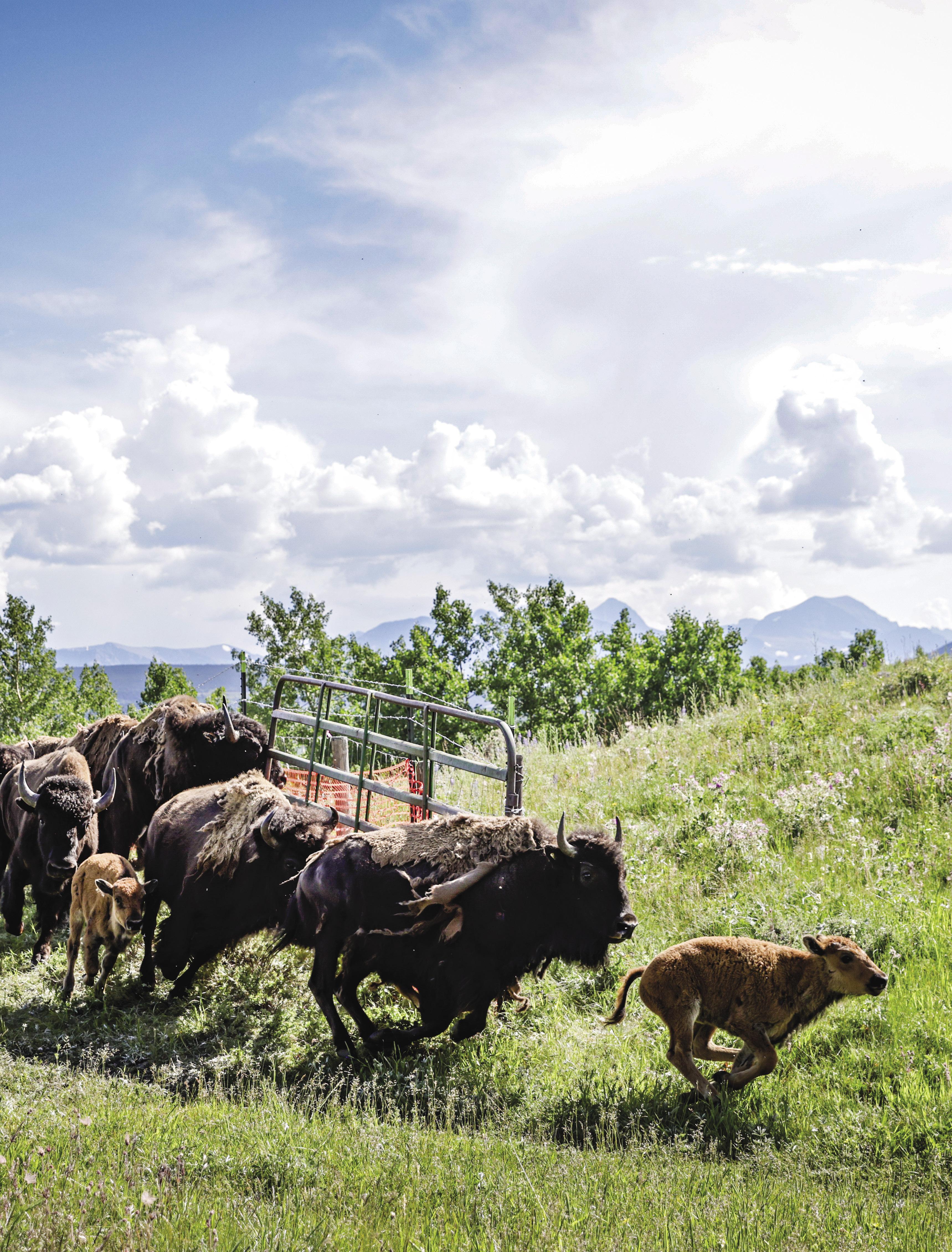
{ A PUBLICATION OF LETHBRIDGE COLLEGE }
2023
WINTER COUNT ROBE 24 STORIES OF THE IINII 34 GRAD ELECTED PIIKANI NATION CHIEF 42 FALL
Wider Horizons is Lethbridge College’s community magazine, celebrating the successes and stories of students, employees, alumni, partners and friends. The magazine aims to educate, engage and delight its readers through compelling stories and images about Lethbridge College people, places and experiences.
In addition to free distribution to our regional community, Wider Horizons is also mailed to all alumni and available on campus. Alumni looking to connect with the college or update their contact information can email alumni@lethbridgecollege.ca or go to lethbridgecollege.ca/alumni.
Readers who would like to receive an e-version of the magazine, comment on a story, change their address or remove their name from our mailing list should email the editor at WHMagazine@lethbridgecollege.ca
Wider Horizons
3000 College Drive South
Lethbridge, AB T1K 1L6
Publisher: Dr. Brad Donaldson
Editor: Lisa Kozleski

Art director/designer: Dana Woodward
Cover photo: Hunter D’Antuono, The Flathead Beacon
Photographers: Lexi Barclay, Tanner Fletcher, Jamin Heller, Rob Olson, Samuel Young
Illustrator: Eric Dyck
Writers: Lexi Barclay, Cathy Gibson-Epp, Melanie Fast, Tina Karst
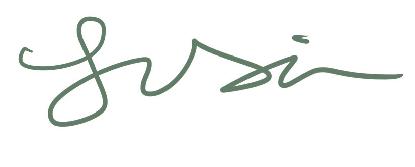
Distribution: Amy Taylor College staff contributors: Kristy Clark, Leeanne Conrad, Ryan Hammell, James Harrison, Melissa Johnson, Greg Kruyssen, Lawrence Krysak, Lanae Morris, Ron Ostepchuk, Derek Rischke, Shawn Salberg, Stephanie Savage, Dawn Sugimoto
Located on the traditional lands of the Blackfoot Confederacy, Lethbridge College is committed to honouring the land from a place of knowing. We honour the Siksikaitsitapi as both the traditional and current Land Keepers of this area, and we welcome all First Nations, Métis, Inuit and non-Indigenous peoples who call Blackfoot Territory their home.
I have spent a lot of time these last months thinking back to Aug. 24, 1990. That’s the day my parents dropped me off at college, an 18hour drive from the three-stoplight, 12-pavedroad small town where I grew up.
I was so excited to be there. I was ready to make new friends, learn about big ideas and explore the world. I remember wanting to rush off to whatever was scheduled at 9 a.m. that last morning before they left, and I was literally jumping up and down on my toes as I rushed through the goodbyes. With hugs, I-love-yous and reminders to call any time, I turned and bolted, never once looking back.
Now as my own 18-year-old twin daughters prepare to head off to post-secondary this fall, I find myself wishing I had paused to turn around and give my parents one last wave. How hard would that have been? But 18-year-old me was already looking to the future, and I couldn’t be slowed down by thoughts of home. That’s the beauty of going to college, isn’t it? That excitement to head into the unknown, to embrace all the newness and learning and growth waiting there – that is such a powerful call.
One thing that is providing me with some comfort as I get ready for my girls to head out on their new adventure is knowing that the excitement to learn new things can continue throughout life. Learning can certainly start at college – but it doesn’t have to end there. And as we put together this issue of Wider Horizons, focused on stories of the buffalo and all it provides to our communities, I had the chance to reflect on that truth. Since starting this job the same September my daughters started Grade 1, I have been encouraged to learn and understand what it means to live, work and grow on Blackfoot Territory. Like so many in my generation, this education was definitely lacking in my earlier years and I had – and have – a lot to learn. But each lesson builds on the last, year after year, and wonderful teachers have been patient with me every step of the way. I think the takeaway is that learning never has to end, and I am grateful to have the opportunity. I would totally be lying to myself if I said I wasn’t feeling emotional about my soon-to-be-empty nest, though. My heart is heavy knowing my girls will probably not remember to turn around for one last wave at the end of August either. But knowing they are just starting out on a journey of lifelong learning is so exciting. And I am so very pleased they are heading off with a far better understanding of the land where they were born and raised than I had. I hope they carry the beauty and bounty of Blackfoot Territory with them in their hearts as they head out into this next great adventure. I hope they know this place is always home (and that they can call anytime).
As always, thanks for reading this issue. If you have any stories of lifelong learning you’ve done – or tips and tricks for getting through an empty nest – email me anytime at WHMagazine@lethbridgecollege.ca. We hope you enjoy this special issue.
Lisa Kozleski Editor
Editor’s message
{ VOL. 17 | ISSUE 1 | FALL 2023 }
{ } | FALL 2023
SEEN ON CAMPUS
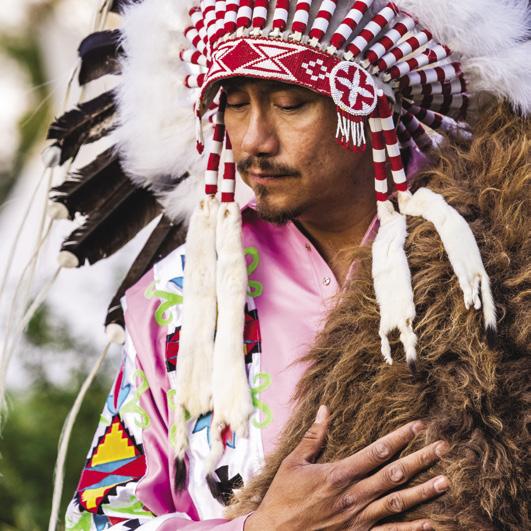
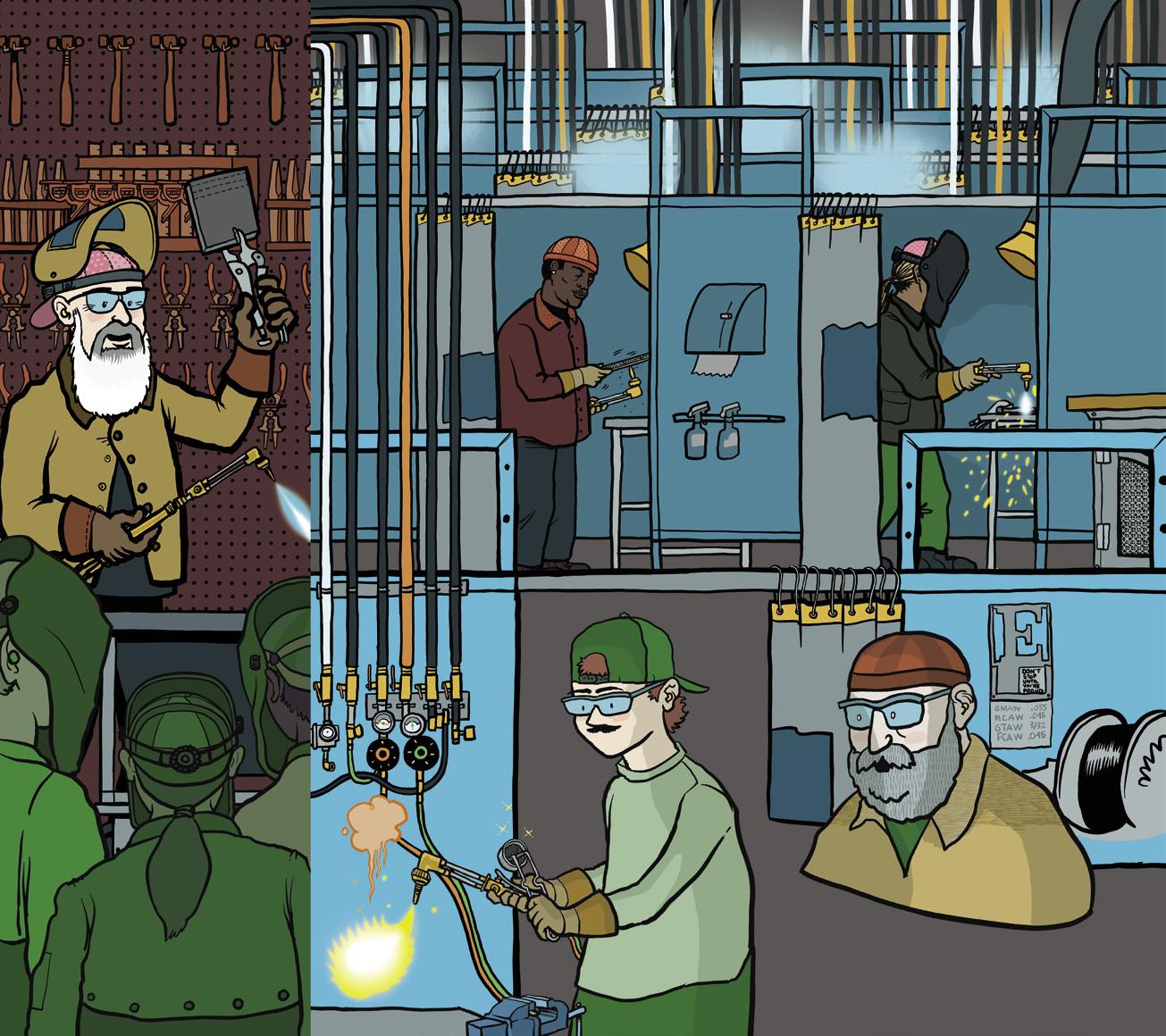

JoJo Kariuki, the outgoing Lethbridge College Students’ Association’s Vice President Student Life, shares a hug with Dr. Samantha Lenci, Provost and Vice President Academic, during the morning convocation ceremony in May. Kariuki, who earned her diploma in Child and Youth Care, has been working in her field since graduation. She was one of about 500 new alumni who crossed the stage during two ceremonies this spring.
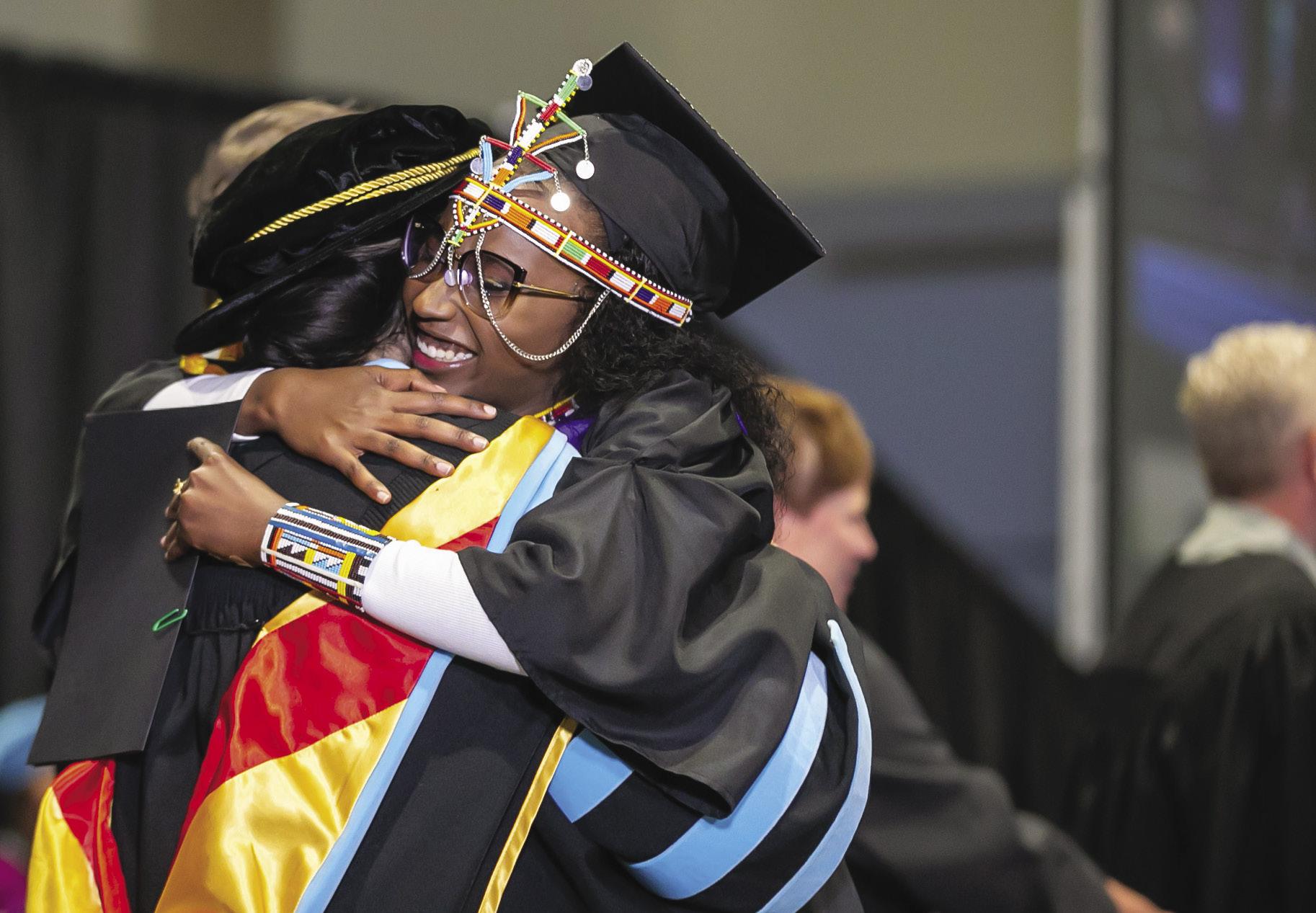
Bison burgers Chef Mark Dieser shares a recipe for bison burgers in a bannock bun. 50
Word
a peek inside the Welding lab, a thoughtfully designed, high-tech, welcoming 16 Journey of the iinii How a buffalo from the Piikani Nation came to be a prominent symbol of traditional Blackfoot Territory on campus. 2 News and notes 6 The president’s view 50 From our kitchens 52 Where are they now? 59 Families in focus 60 The last word 60
The Last
Take
1
Photo by Samuel Young

News and notes
College receives $1 million in federal research funding for irrigation infrastructure 2 | FALL 2023
Story by Cathy Gibson-Epp | Photos by Tanner Fletcher
AS YOU LOOK OUT ON THE VAST FIELDS ACROSS SOUTHERN ALBERTA BUSTLING WITH THE HARVEST AT THIS TIME OF YEAR, YOU MIGHT NOT KNOW HOW MUCH WORK, WATER AND RESEARCH WENT IN TO GETTING THE CROPS TO THIS STAGE. SOUTHERN ALBERTA HAS BEEN A LEADER IN IRRIGATION FOR DECADES, AND LETHBRIDGE COLLEGE RECENTLY RECEIVED ANOTHER BOOST FOR IRRIGATION RESEARCH.
The Canada Foundation for Innovation (CFI) College Fund recently awarded the college $1 million in infrastructure funding to expand the capacity of its applied research in irrigation science. The grant, which was announced in June, is supporting infrastructure needs at the Mueller Irrigation Group’s Smart Irrigation Farm, located at the Lethbridge College Research Farm just east of Lethbridge.
“The CFI grant will help us to increase the capacity of our group to do plot and field scale experiments on the LC research farm,” says Dr. Willemijn Appels, Senior Applied Research Chair for the Mueller Irrigation Group. “We’ll be able to purchase the latest irrigation technology and plant/soil sensing equipment to investigate the effects of management decisions regarding irrigation management, nutrient and land management on soils and crops in great detail. Our goal is to distill practical management strategies for precision agriculture from this detailed work.”
The CFI funding is being used to upgrade the irrigation equipment on the research farm. The centre pivots and linear move systems will be outfitted with variable rate irrigation technology, remote communication systems and other equipment required to make site-specific irrigation management possible. The research team will also purchase sensors that will increase the capability to get instant observations of plant, soil, and weather conditions anywhere on the farm. The funding will also help provide some pieces of agricultural equipment that will be used in plot and field experiments, as well as a couple of pieces of lab equipment that will allow researchers to perform some sample analysis on campus that was previously outsourced.
“The equipment will also boost our capacity for laboratory work as well, which means that we will need to have less analysis done by third parties and can do more in house,” Appels adds. “That’s great for our own research and student projects, and it will also increase our flexibility to work with industry.”
“The equipment will also boost our capacity for laboratory work as well, which means that we will need to have less analysis done by third parties and can do more in house. That’s great for our own research and student projects, and it will also increase our flexibility to work with industry.”
The new equipment will provide the latest developments in the field of precision irrigation and will significantly increase the college’s capacity to perform precise research investigations of soil and crop quality.
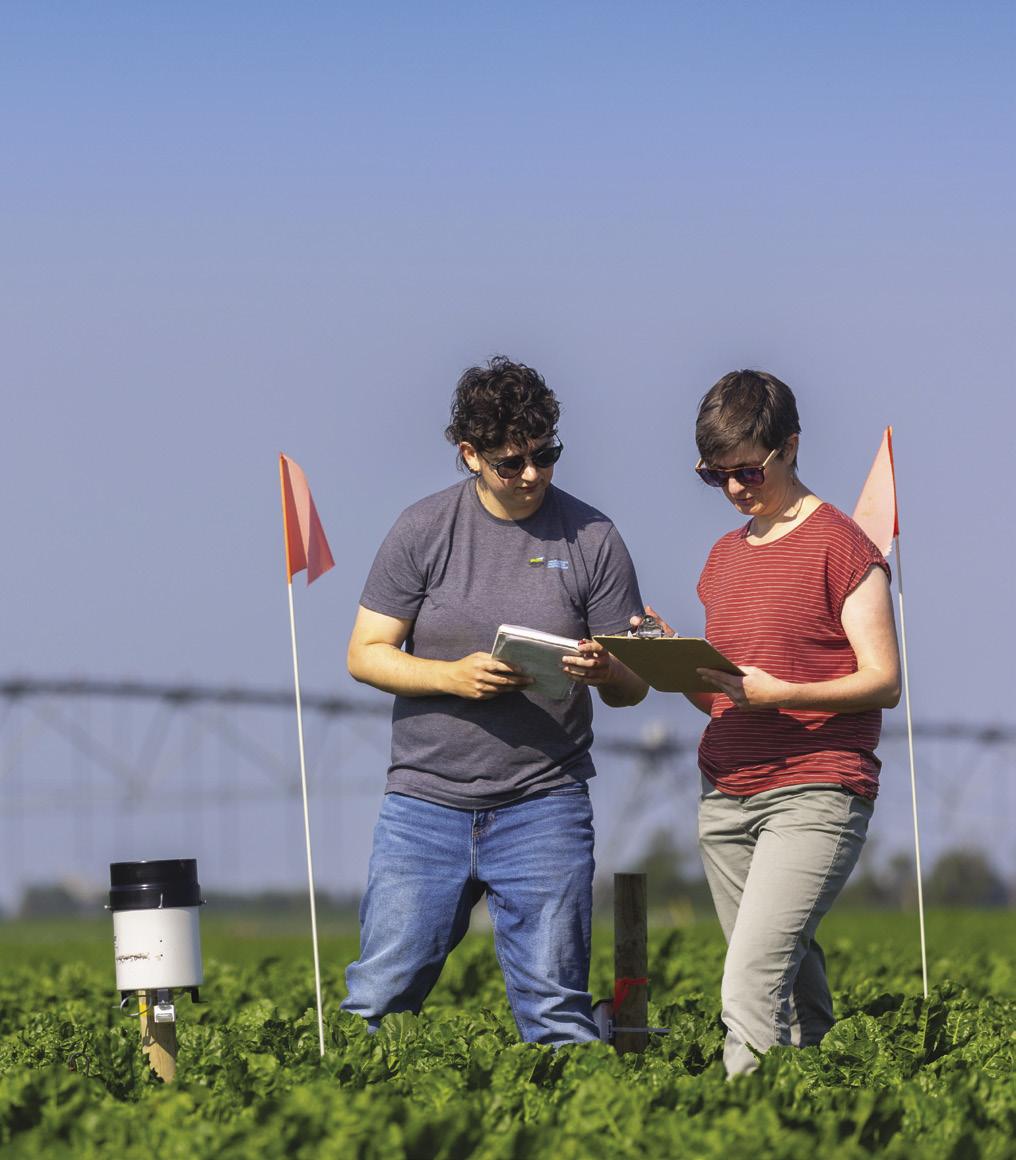
This is the college’s fifth CFI grant. The Aquaculture Centre of Excellence was originally funded by a CFI grant in 1997. In 2019, the college received CFI funding for its Centre for Sustainable Food Production, and in 2021, the college received two separate grants for the Advanced Post-harvest Technology Centre and the Spatial Technologies Applied Research Training (START) Centre.
The applied research being done by Dr. Appels and her Mueller Irrigation Group is featured in the latest annual report by Lethbridge College’s Centre for Applied Research, Innovation and Entrepreneurship. Email WHMagazine@lethbridgecollege.ca if you’d like a hard copy of this publication, or read it online at learn.lc/CARIEreport2023.
3
Dr. Willemijn Appels (right) and student research assistant Aleks Calic (left) at the Lethbridge College Research Farm.
TOP TEN FROM THE DEN
Wider Horizons turned to the people who know the ins and outs of campus best – Lethbridge College employees – to get their picks of the top news stories from the past four months. Here’s what they had to say.
provinces working collaboratively towards advancing ag tech solutions and sustainability across Canada. The network of Smart Farms supports Canada’s agriculture sector to enhance efficiency, sustainability, and resilience in response to emerging opportunities and challenges.
STUDENT PART OF PROVINCIAL PANEL ON NEWCOMER EXPERIENCE
Congratulations go out to Dr. Juan Carlos Olivares Contreras, a student finishing the program in Lethbridge College’s English Language Centre. He was part of a six-person panel discussing the newcomer experience in Canada that kicked off the Premier’s Summit on Fairness to Newcomers on March 17 in Calgary. A physician with more than a decade of experience in Mexico, he now works as a pharmacy assistant. He hopes to serve as a doctor again.
SUNTERRA GREENHOUSE, COLLEGE RESEARCHERS MAKE DISCOVERIES SUPPORTING GREENHOUSE INDUSTRY
New research findings will help greenhouse producers make informed decisions for growing more produce while saving money. The project, run collaboratively by researchers from Lethbridge College’s Centre for Applied Research, Innovation and Entrepreneurship and the grow team at Sunterra Greenhouse, tested novel varieties of strawberries and tomatoes under diverse greenhouse growing conditions. Funded by Results Driven Agriculture Research, the $780,0000 project explored numerous techniques and technologies for controlledenvironment agriculture. The results of the pre-commercial trials will help Sunterra and other greenhouse producers make informed choices for greenhouse construction, planting and crop management.
STONE PIPE DAYS CELEBRATED AT LETHBRIDGE COLLEGE
Stone Pipe Days, the annual celebration to recognize the pride, history and knowledge of the Indigenous community at Lethbridge College, took place in March, and the community joined in the festivities. In addition to showcasing drumming, dancing, singing, traditional Indigenous foods and more, this year’s celebration included the historic signing of the Buffalo Treaty by the college.
CAMPUS COMMUNITY GATHERS TO RAISE PROGRESSIVE PRIDE FLAG
Members of the Lethbridge College and 2SLGBTQIA+ communities gathered on campus in June to raise the flag in celebration of Pride Month. This is the eighth year the college has flown the Pride Flag in June and the third time it has raised the Progressive Pride Flag, which promotes inclusivity by recognizing trans individuals, marginalized people of colour, and those who are living with or who have died from HIV/AIDS.

BE READY TO CELEBRATE AT COULEE FEST ON SEPT. 16
Coulee Fest – Lethbridge College’s free family festival – will take place from 1 to 7 p.m. on Sept. 16. Attendees will enjoy annual Coulee Fest favourites including live music, a petting zoo and other family entertainment, food trucks, the Hudsons Canada’s Pub beer gardens, the Prairie Made Market and much more!
COLLEGE JOINS THE PAN-CANADIAN SMART FARM NETWORK
Lethbridge College joined the PanCanadian Smart Farm Network, led by Olds College of Agriculture and Technology. The college became the seventh member from across four
News and notes 6 7 5 10 9 8 4 | FALL 2023
HONOUR WALL OF SKILLS COMPETITIONS MEDALISTS UNVEILED
Lethbridge College unveiled a special display in March to honour former medal winners from skills competitions. A brief ceremony, attended by some previous winners, was held just before the winners of the South West Regional Skills high school event were announced.
START
Lethbridge College celebrated the grand opening of its Spatial Technologies Applied Research and Training (START) Centre in March. Part of the college’s Centre for Applied Research, Innovation and Entrepreneurship, the START Centre partners with organizations in Alberta and beyond to apply virtual reality and/ or augmented reality technologies and real-time 3D to solve challenges in key sectors including agriculture, energy, architecture, health care, cultural heritage and emergency response.

College receives national award for Indigenization project

The Canadian Collegiate Athletic Association announced in June that Lethbridge College won its Innovation Award for the college’s “We are Aikowania” video and facility reconciliation initiative. The award recognizes a member institution that has developed an initiative demonstrating unique marketing, communication or technological advances in its athletic program. The two-minute video was first shown in September 2022 at the unveiling of the college’s new Indigenous logo on its home court, and it has been shown many times since, including at convocations, community events and championship games.
GRANT FOR $300,000 TO SUPPORT NEWCOMERS INTERESTED IN TRADES
Lethbridge College is ready to support newcomers with an interest in trades thanks to a $300,000 Settlement, Integration and Language Projects (SILP) grant. Awarded by Alberta’s Ministry of Trade, Immigration and Multiculturalism, SILP funding supports projects that work toward strengthening a diverse and inclusive workforce by helping communities attract, welcome and retain newcomers.
You can read all of these stories and more at lethbridgecollege.ca/news.
CENTRE CELEBRATES GRAND OPENING WITH CUTTING-EDGE DEMOS
2 1 4 3
Thanks to our college colleagues who helped shape this list!
5
Photo by Jamin Heller
by Dr. Brad Donaldson
The President’s View
As a young engineer, I was part of a team that included many senior engineers and managers. After a few meetings, my manager took me aside and encouraged me to offer my opinions and thoughts. He told me: “We want to make sure all opinions and ideas are on the table.” I then realized that although I knew I belonged, his words helped me know, even more importantly, that I mattered. We all matter – whatever our geographic, social, economic, ideological or personal background.
Inclusivity does not necessarily mean 100 per cent agreement with others’ perspectives; rather, it means respect for and consideration of those other perspectives. There is a caveat though:

all perspectives must be given and considered with care and respect. Perhaps care and respect are what equity, diversity and inclusion are all about.
There have been many times through my career and personal life where I have changed my view and critical decisions based on carefully considering the diverse perspectives I have been offered. And sadly, I also have examples of not considering the input of others – to my detriment. I believe many of the societal divisions today are rooted in the lack of an equity, diversity and inclusion mindset. Closed-minded perspectives block the opportunity to create a more harmonious, caring and respectful society.
As educators, we have a powerful opportunity and obligation to further open the minds of those who entrust us with their development and growth. They can move on from Lethbridge College with the perspective of caring and respect to enable a more inclusive and compassionate community. We have the responsibility to create a caring and respectful environment here, where everyone is included and valued, and where we work every day –like that senior manager did at the beginning of my career – to help others remember that we all belong, and we all matter.
News and notes
Lethbridge College President and CEO Dr. Brad Donaldson was among college community members who joined in Lethbridge’s Pride Parade in June.
6 | FALL 2023
Photo by Samuel Young
IN MEMORIAM
Wider Horizons learned of the passing of three members of the college community in recent months. Condolences are extended to their families, friends and former colleagues.
Jody Alston, who spent the last two decades as an instructor in the English Language Centre (ELC), passed away July 28 at the age of 65. She was described as the backbone and light of the ELC, revered by teachers and students alike.
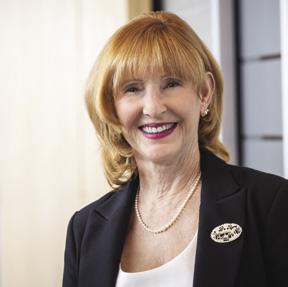
Sandra Baceda, who taught classes and worked in Information Technology Services (ITS) in the 1990s and early 2000s, passed away in April at the age of 82. She was one of the original staff members in ITS and retired in 2004.
Jeff Bronsch, a member of the college’s Alumni Advisory Council, died on June 6. He also served on the Program Advisory Committee for Agricultural Sciences, was a mentor in the AgENT program and supported many college initiatives.
Provincial funding takes career development to next level
Six southern Alberta school divisions –Palliser, Lethbridge, Holy Spirit, Horizon, Westwind and Livingstone Range –were thrilled to receive over $6 million in funding from Alberta Education in April to help launch the Southern Alberta Collegiate Institute. Created in partnership with the college and Career Transitions, the institute will encourage students to find career pathways and build capacity in areas such as trades, agriculture and more.
Congratulations to the following Lethbridge College community members for making a difference in their life, work and community. Here are some highlights of their successes:
Sandra Bartlett Atwood, Indigenous Studies instructor, co-authored an article published in the April issue of the journal Society and Natural Resources. It proposes a collective approach to research that includes Indigenous worldviews alongside western approaches.
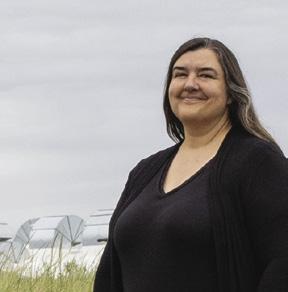
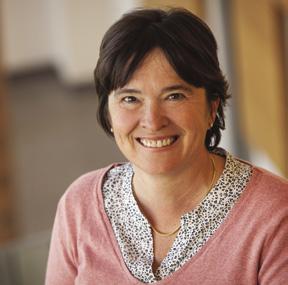
Natalie Barfuss, instructor in the School of Business, was published in the fifth Canadian edition of the interpersonal communication textbook, Look: Looking Out, Looking In
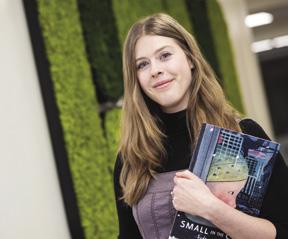
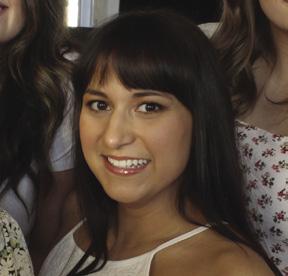
Dr. Rebecca (Becky) Fitzgerald, recently retired associate dean in the Centre for Health and Wellness, defended her dissertation titled “A Storied Picture of Hope: Using Narrative-Photovoice to understand International Students hope in Asynchronous Learning Communities.”
Nadia Hand, who works in Applied Research and has been completing her thesis in Microbiology in instructor Sophie Kerneis-Golsteyn’s laboratory, presented her research at the Sustainable Agriculture Showcase at the University of Lethbridge. She will defend her thesis in September.
Dr. Amy Hodgson-Bright had an article titled “Sparking Interest in Writing: Author Visits as a Tool to Enhance Learning, Motivation, and Connection” published in the summer 2023 issue of The ALAN Review.
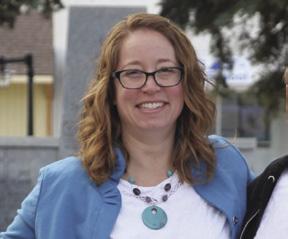
Microbiology instructor Sophie Kerneis-Golsteyn presented a paper titled “Nature’s remedy: Harnessing the power of Canadian phytobiotics for healthy and sustainable livestock production” at a conference in Paris in June.
Engineering Technologies students Wyatt Adams, Garrett Carlson, Macallister Chambers, Shannon Cote, Anne Cronemberger, Tyce Daniells, Cade Francis, Jesse Giesbrecht, Kevin Janzen, Todd Joosse, Cody Lamb, Olivia Leonard, Jackson Lowe, Josh May, Kelly McQuaid, Logan Oliver, Kyle Purvis and Nolan Ranger won the award for Structural Ingenuity at the annual CanStruction event this spring (and filled the shelves of local food banks, too).

NEWS 7
CAMPUS KUDOS CAMPUS
Colleague honoured with headdress at pow wow
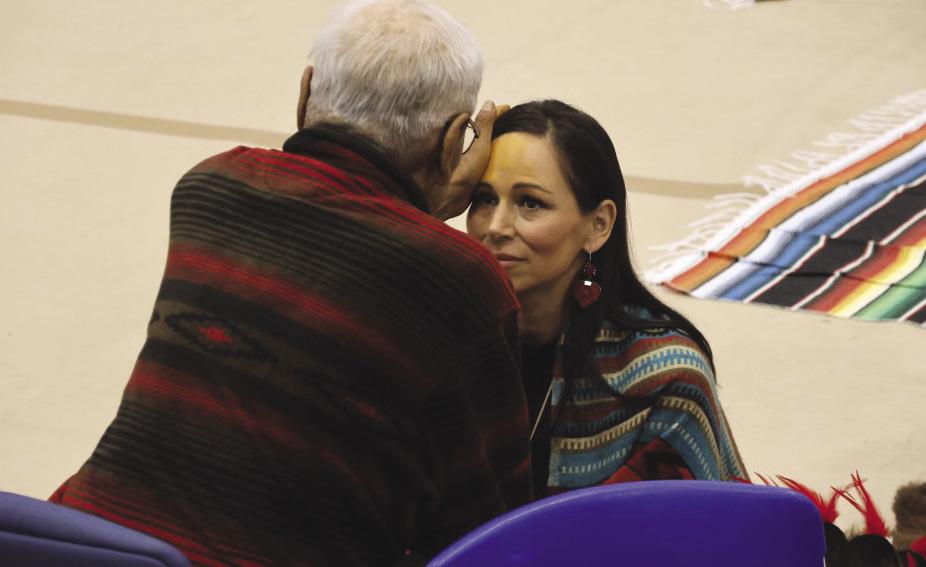
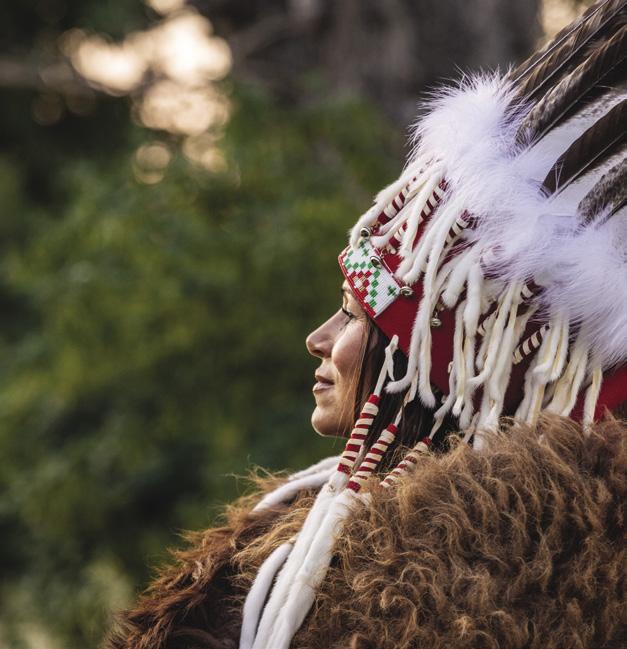
Among the flashes of colour and the steady beating of drums, a special moment happened for Marni Hope at May’s Ohkotoki’aahkkoiyiiniimaan Pow Wow. Hope, Indigenous student support and event coordinator, received a headdress through a transfer ceremony guided by three prominent Blackfoot knowledge holders from the Blackfoot Confederacy: Lowell Yellowhorn, Indigenous Services manager from the Piikani Nation; Clarence Wolfleg from the Siksika Nation; and Bruce Wolf Child from the Kainai Nation.
Headdresses signify a sign of leadership and achievement and show that the wearer is “walking a good path and it needs to be recognized,” explains
Hope, who says she was guided by Yellowhorn in the process of getting transferred the rights to become an Eagle Feather Headdress holder.
The ceremony included being captured by current headdress holders –Yellowhorn and Wolfleg – which means she was chosen as someone who will represent the responsibilities of taking care of a headdress. The performance of a sacred capturing ceremony and use of sacred face painting protocols helped secure the transfer ceremony.
Hope was also honoured in the Community Involvement category at the Esquao Awards Gala in May. The Esquao Awards highlight the significant role Indigenous women hold in their home, in the healing and development of their communities, and in the building of Alberta.
Apprentice named best Heavy Vehicle tech in Canada
Story by Melanie Fast | Photos courtesy Skills Canada
Representing the province on a national stage and showcasing skills while under the scrutiny of judges, peers and a ticking clock brings a whole new meaning to working under pressure. That’s something that Walter Loedeman, a soon-to-be fourth year apprentice in the Heavy Equipment Technician program at Lethbridge College, has shown he can manage with ease. Loedeman took home gold medals at both Skills Alberta and Skills Canada in May and is now gearing up to compete in the Heavy Vehicle Technician category of the WorldSkills Competition in Lyon, France, in 2024. The international competition takes place every two years and is considered the largest and most influential skills competition in the world and represents the best of international excellence in skilled trades and technologies.

Ethan Wagenaar, who graduated from the Automotive Systems program this spring, won silver at Skills Alberta and bronze at Skills Canada. Skills Canada was established in 1992 with an aim to equip young minds with trades skills that help students and apprentices compete successfully in a drastically changing world market. Students compete provincially in one of 45 trade and technology areas and the gold medal winners move on to nationals where they compete to qualify for the world stage. Since Skills competitions began in 2002, Lethbridge College students have won 20 medals.
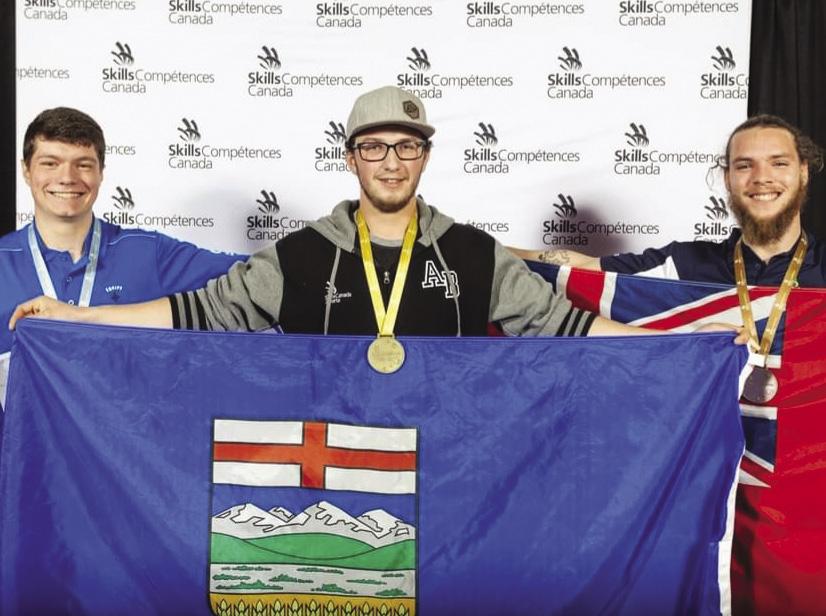
News and notes
8 | FALL 2023
Lethbridge mentor receives honorary degree

Dave Jackson – a mentor, philanthropist and integral part of Lethbridge’s thriving construction industry –received an honorary bachelor’s degree as part of the college’s Spring 2023 Convocation ceremonies. He is the 22nd person to receive this honour. Jackson has been involved in the construction industry for nearly half a century, and he and his wife have been owners of Lealta Building Supplies in Lethbridge since 2012. Throughout his career, he has supported many Lethbridge organizations and initiatives through his business and his personal passions, including Youth One, a Lethbridge
organization that offers mentorship based after-school programs and support services for youth that he has been involved with since its creation in 2014.
“Whether he is helping to shape the lives of young people in our community through his work with Youth One, serving on the STARS Foundation, or supporting Shelter Canada, the Southern Alberta Community Living Association, Therapeutic Riding Association, the Lethbridge Food Bank or other important organizations, Dave has fostered a gracious and charitable reputation by putting in the work, giving back to the community and being the silent driver behind critical community improvements,” says Stephanie Savage (Digital Communications and Media 2018), Lethbridge College’s manager of Alumni and Engagement. “Dave consistently models and inspires integrity, humility, kindness and leadership, and he is a worthy recipient of this honour.” Jackson was formally recognized with a hooding ceremony and degree
presentation during the first of two Spring 2023 Convocation ceremonies in May; he also gave a moving speech to his fellow grads. Lethbridge College Honorary Degrees are presented to outstanding individuals who have made significant contributions to education or who demonstrate a commitment to values aligned with the college.
College accredited to provide prestigious coaching program
Lethbridge College has received International Coaching Federation (ICF) accreditation to become the only post-secondary institution in Alberta to offer this highly sought-after training. LC Extension, the college’s learning solution and continuing education provider, will be offering the Leader as Coach program in September and again in January. Those who successfully complete the program will have a clear pathway to pursuing their Associate Certified Coach credential from ICF. Learn more at lethbridgecollege.ca/lcextension.
College teams paddle their way to success at Dragon Boat Festival
At June’s ATB Rotary Dragon Boat Festival in Lethbridge, two college teams joined forces to proudly represent the college for the 14th consecutive year. The college’s competitive team, the LC Klippers, won a silver medal in the Reynar Cup, which features the top four competitive teams from Lethbridge. They went on to claim first place in the Competitive A consolation race. The college’s recreation team, the LC Cracked Paddles, outperformed 12 other teams in the Recreation category, securing a well-deserved first-place finish with a time of 2:20:75.

9
Kodiaks celebrate 2023 KODI award winners
The Lethbridge College Kodiaks celebrated a successful 2022-23 sporting season with the annual KODI Awards in April. The event brought together the Kodiaks teams, staff and college officials to celebrate the athletic and academic achievements of Kodiaks studentathletes. The awards capped another strong season for Kodiaks Athletics, one that saw every Kodiaks team compete for their respective conference championships.
The three pillars of Kodiaks Athletics – academic accountability, athletic excellence, and the student-athlete experience – steered the voting on all awards. Awards are selected by members
of the Kodiaks Athletics administration team and factor in the results of a public vote that had 615 participants, setting a new KODIs record. Below is a list of the KODIs major awards; the complete list can be found online at gokodiaks.ca.
• Cooper Williams (men’s cross-country/ indoor track) – Tim Tollestrup Leadership/ Athlete of the Year (male)
• Jamie Brown (women’s volleyball) –Tim Tollestrup Leadership/Athlete of the Year (female)
• Men’s indoor track – Val and Flora Matteotti Team of the Year
• Ryan Heggie (men’s basketball) –Electrical Solutions Inc. Kodiaks Coach of the Year
Stories by Lexi Barclay
• Samantha Demchuk (women’s soccer/ futsal) – Calgary Flames Foundation Leadership Scholarship (female)

• Julio Vega (men’s soccer/futsal) –Calgary Flames Foundation Leadership Scholarship (male)
• Men’s indoor track winning ACAC championships –Best championships performance
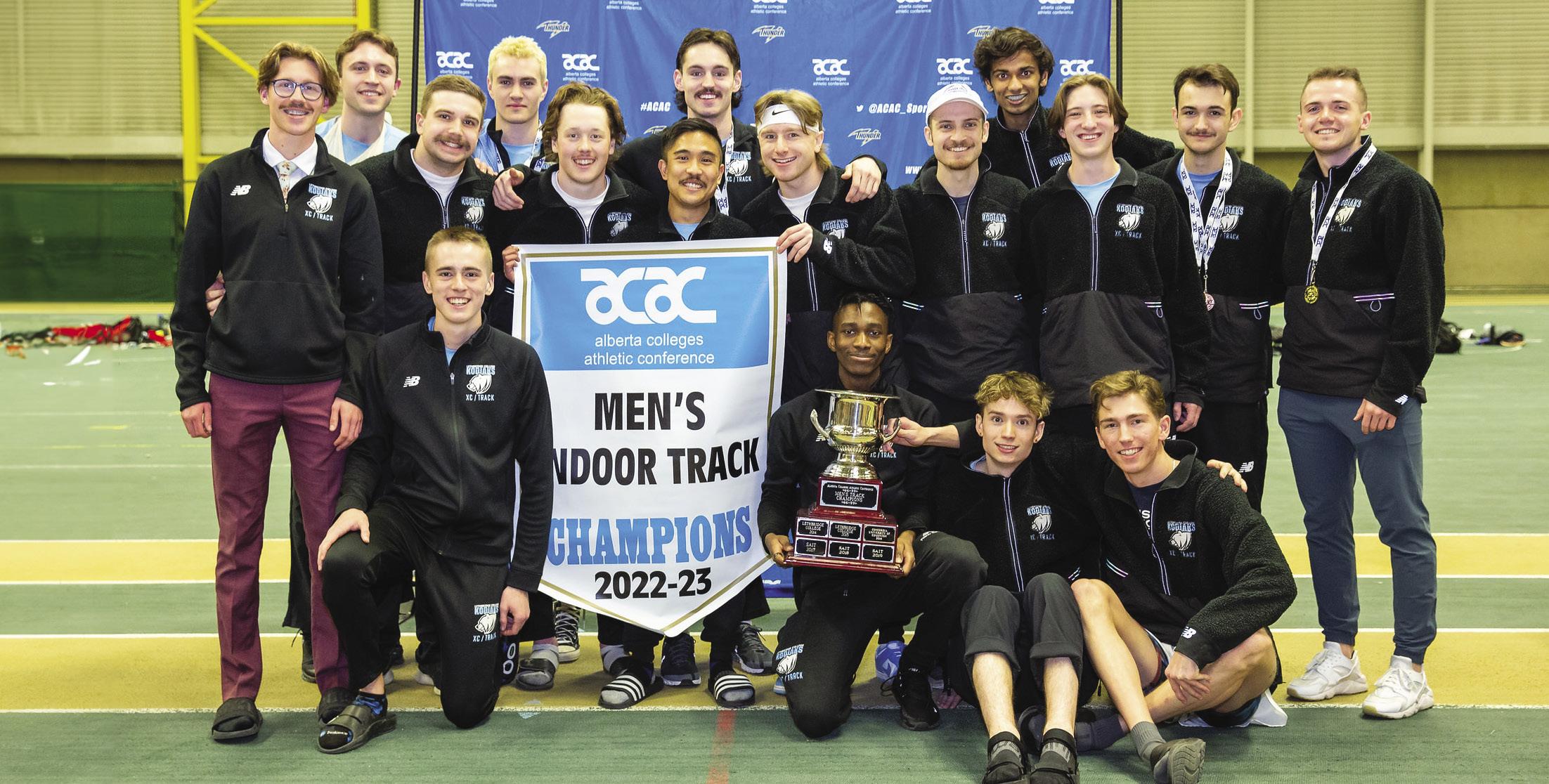

• Men’s basketball – Best upset. Facing a Keyano team that went undefeated in the regular season, the Kodiaks put forth a complete effort and downed the Huskies 80-72 to claim an ACAC bronze medal.
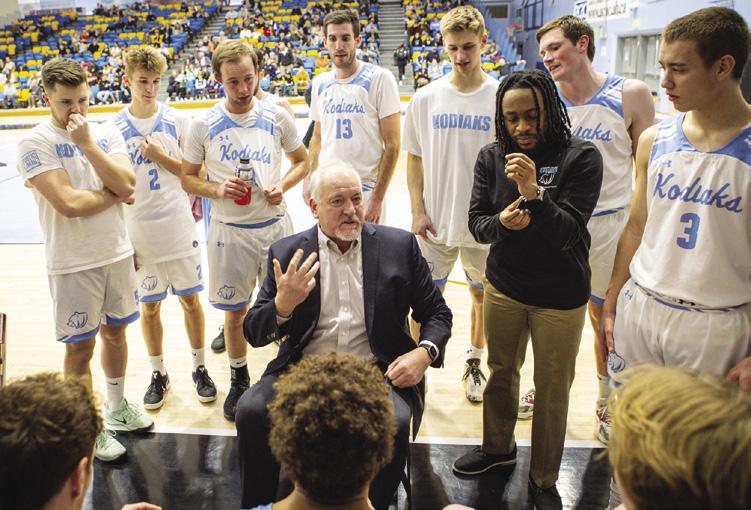
• Women’s volleyball – Best comeback. The team was down 2-0 in the ACAC quarterfinals and came back to defeat the nationally ranked number six team, The Kings University Eagles, in a five-set thriller.

News and notes
10 | FALL 2023
College to host cross-country and women’s volleyball championships in 2023-24
Lethbridge College will serve as host for both men’s and women’s crosscountry and women’s volleyball Alberta Colleges Athletic Conference (ACAC) championships for the upcoming athletics season.
Ten men’s and women’s crosscountry teams will travel to Lethbridge for the Oct. 28 race at Nicholas Sheran Park, located on the city’s west side. The women will run six kilometres and the men will run eight through the park. The course is still being finalized.
The last time the Kodiaks hosted ACAC championships for cross-country was in 2015, when they won both the men’s and women’s titles. Last season, the Kodiaks men’s cross-country team earned a bronze medal at ACAC championships. Rookie Cooper Williams finished seventh overall and was named to the all-conference team.
The women’s volleyball team will host the top eight teams in a crossover format – four from the North division and four from the South – from Feb. 21 to 24, 2024. The tournament will take place in the Val Matteotti Gymnasium. The teams will compete for the conference title and a spot at nationals, to be hosted by Red Deer Polytechnic in early March. Last season, the Kodiaks women’s volleyball team went on a historic run at the ACAC championships, when they had the highest finish in program history, placing fourth overall. Updates and more information about these upcoming championships can be found at www.acac.ab.ca.
Kodiaks futsal players compete for Team Yukon at nationals
Story by Kathleen Bernal
Kodiaks women’s soccer and futsal players Malorie Hanson (Therapeutic Recreation Gerontology), Samantha Demchuck (Nursing), Megan Morrison (Nursing) and Jayna Timinski (Child and Youth Care) were among those who competed for Team Yukon at the 2023 Futsal National Championships in April. The tournament, held at the Seven Chiefs Sportsplex in Calgary, brought together teams from across Canada. Team Yukon finished in sixth overall, playing teams from Nunavut, Ontario, B.C. and Manitoba.
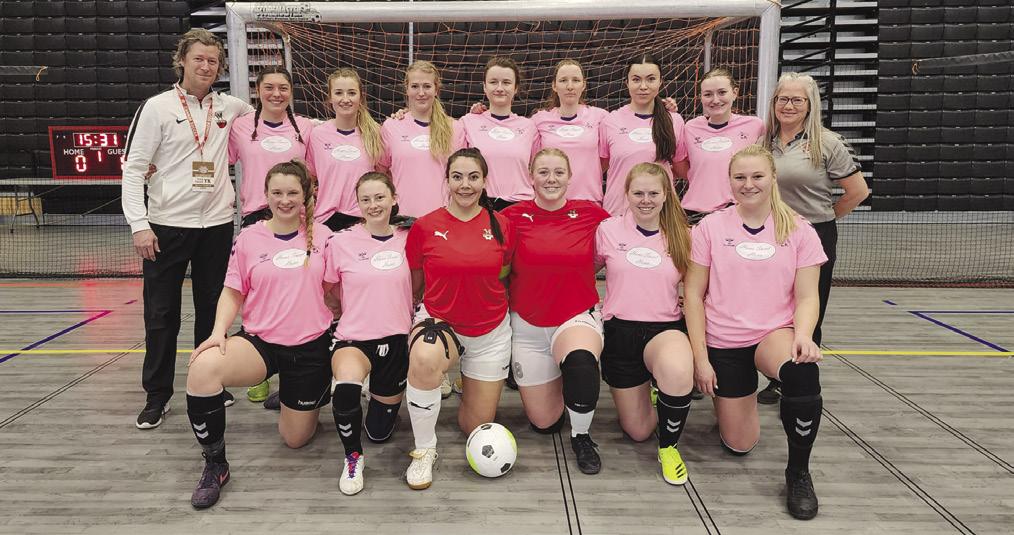
Third-year Kodiaks futsal player Malorie Hanson says she’s watched Team Yukon compete from the sidelines for years, and being chosen to play after a tryout process was exciting. “It was incredible, probably one of the best tournaments I’ve ever been to,” says Hanson. “I felt like we played really well. It was exciting to get to a national level event and be competitive.”
Hanson hopes to build on the skills she gained during competition next season with the Kodiaks. “They’ll really help improve my game and hopefully some of my other teammates who were at futsal nationals will also take some things away
Six Kodiaks student-athletes named Academic All-Canadians
The Canadian Collegiate Athletic Association (CCAA) announced that six Lethbridge College Kodiaks studentathletes are among the 2022-23 CCAA Academic All-Canadian award recipients. The CCAA Academic All-Canadian award, presented by Brandnew Athlete, is the CCAA’s most prestigious studentathlete honour, epitomizing a commitment to academic success and athletic achievement.
CONGRATULATIONS TO:
Paycen Blackmore - basketball
Cooper Williams - cross-country running
Joel McLeod - soccer
Nicole Stahl - soccer
Taylor Hrycun - soccer
Jamie Brown - volleyball
and just make us more effective players,” adds Hanson. “I also developed my understanding of futsal in general and it just made me excited and motivated to get back to training.”
Kodiaks women’s soccer and futsal head coach Sean Carey says playing at nationals gives the players confidence to grow their game and can help future recruitment to the Kodiaks program. “It’s going to take our program to another level when we’ve got these players playing at that level and playing against some of the best players in all of Canada,” says Carey. “It helps build what we’re trying to build here and we’ve been so close with futsal to get to that gold metal and hopefully that’s just another step forward for us.”
11
CELEBRATING LETHBRIDGE COLLEGE
STORIES OF THE IINII (BUFFALO), BOTH THE OLD (THE ANIMAL) AND THE NEW (EDUCATION)
IN HONOUR OF THE IINII
The Blackfoot word for grandparent is Kaahsinnoonik, and when Lethbridge College’s Kainai Kaahsinnoonik Peter Weasel Moccasin (Miiniipooka/Berry Child) starts to tell a story, listeners are drawn in as quickly as if they were listening to the grandparents of their childhoods. Whatever tale or teaching Weasel Moccasin shares, his audience – usually a mix of students, alumni, employees and friends of the college – eagerly follows all of the ups and downs, listening for Weasel Moccasin’s familiar joyful laugh along the way.
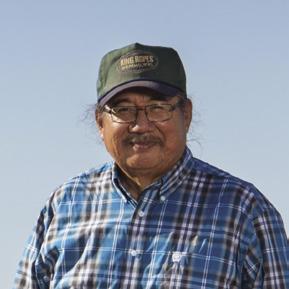
12 | FALL 2023
Story by Lisa Kozleski | Photos by Hunter D’Antuono
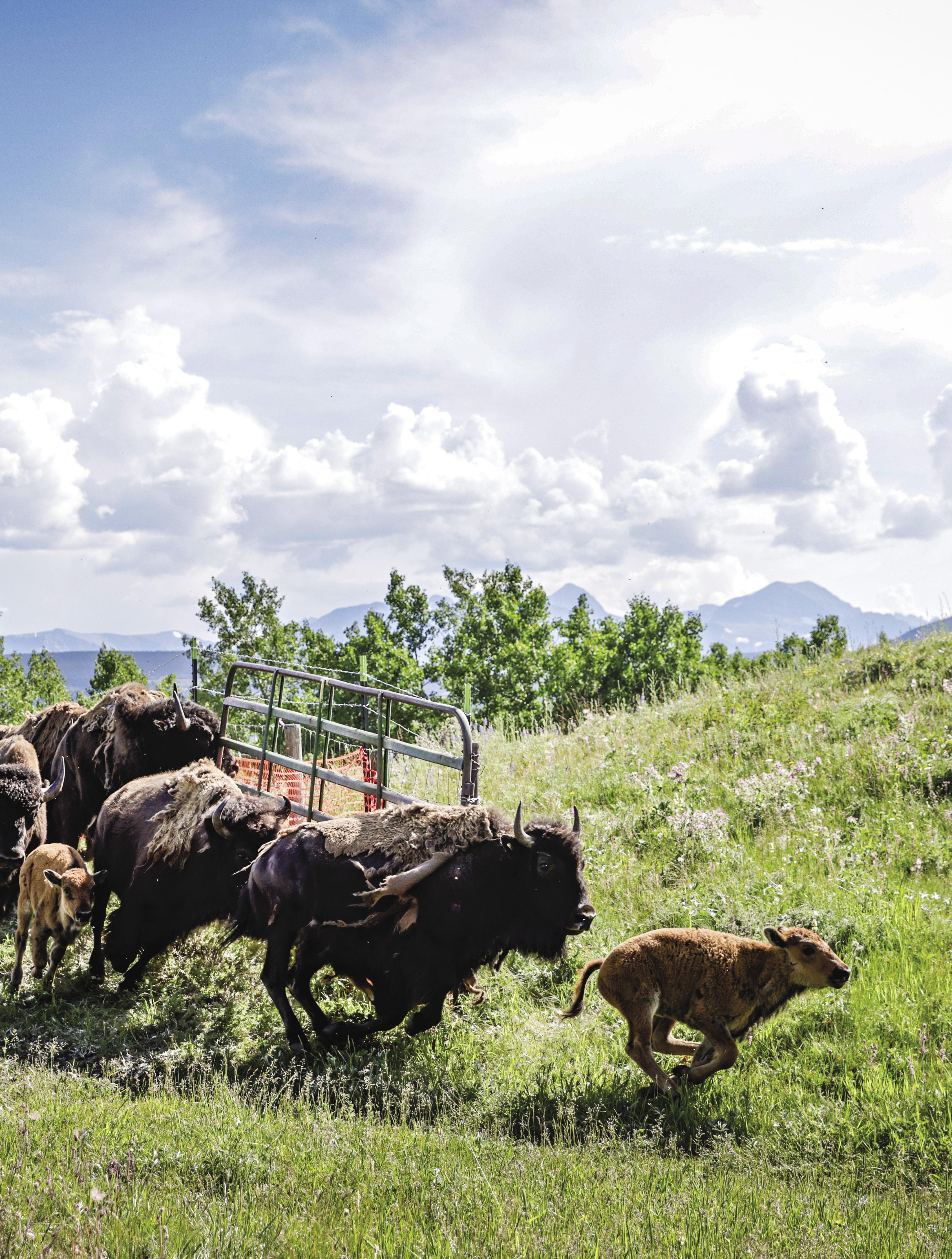
13
“THE ANSWERS ARE IN THE STORIES. THE STORIES ARE THE REMINDERS. WHICH PATH ARE YOU GOING TO CHOOSE? WHICH PATH ARE YOU GOING TO TAKE?”
PETER WEASEL MOCCASIN
MIINIIPOOKA / BERRY CHILD
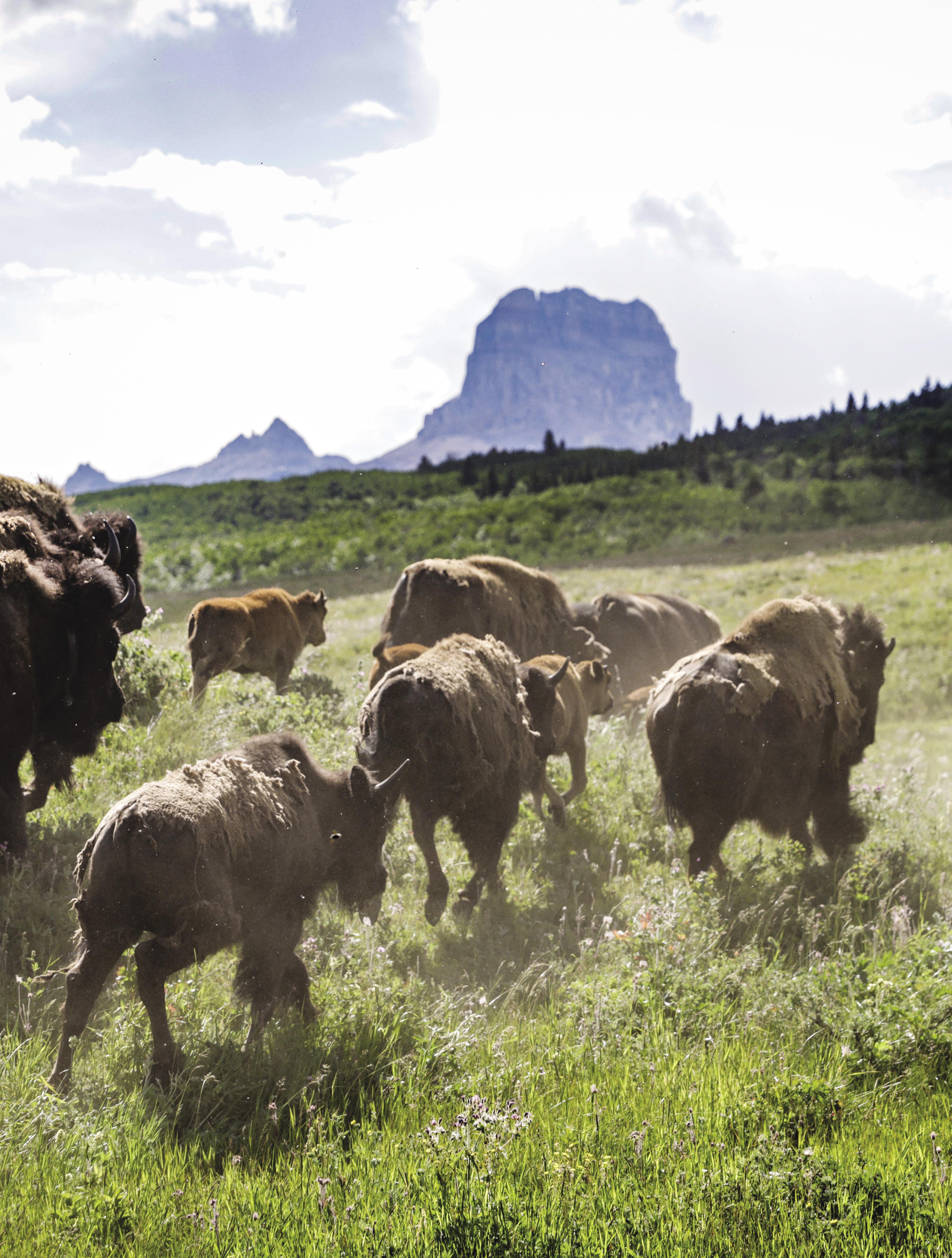
14 | FALL 2023
In June, a herd of 24 wild iinii were released at the base of Chief Mountain (Ninaiistáko) in Montana, returning to roam the beautiful lands where they once ruled.
The Blackfoot word for buffalo is iinii, and Weasel Moccasin has no shortage of stories to share about this animal that has been sacred to the Blackfoot people since time immemorial. He might start with the lessons he heard from his father on late nights in front of a warm fire, and then move on to memories of buffalo harvests he has been on. He can use words to paint a vivid picture about how Winter Count Buffalo Robes carry the stories of communities, and he can tell you a thing or two about buffalo stones. He offered a prayer “in my own way” before the historic signing of the Buffalo Treaty at Lethbridge College this spring, and as of this summer, he has a new story to tell, one about what he felt and saw as he prayed with other Blackfoot elders before the release of a herd of 24 wild iinii at the base of Chief Mountain (Ninaiistáko), returning to roam the beautiful lands where they once ruled.
“The answers are in the stories,” says Weasel Moccasin, who received an honorary degree from Lethbridge College in 2018. “The stories are the reminders. Which path are you going to choose? Which path are you going to take?”
Woven throughout all of Weasel Moccasin’s tales about the iinii is one more idea – how education can be viewed as “the new buffalo.”
“In today’s Blackfoot worldview, education is seen as the new buffalo, being that an education is the pursuit of lifelong knowledge, the ultimate goal,” says Kainai Knowledge Keeper and artist William Singer III (Api’soomaahka/Running Coyote), the artist who painted the story of Lethbridge College on its new Winter Count Robe. “As with the buffalo, education empowers the individual to succeed by providing for themselves and the community, which leads to the longevity of the people.”
This special issue of Wider Horizons is full of stories from Lethbridge College people sharing their experiences with the iinii – both the old (the animal) and the new (education).

“We have so much we can learn from these stories that connect to our people here at Lethbridge College and the learning that happens here each day,” says Lethbridge College President and CEO Dr. Brad Donaldson. “I’d also like to acknowledge and celebrate the work of our talented and dedicated Indigenous Services team. Their leadership has facilitated so much of this work – and they generously guide colleagues, students and friends of the college in the path toward reconciliation. Like the path of the buffalo, it might not be straight. But we are grateful to have them leading us on this journey.”
Special thanks go out to Wider Horizons colleague Tina Karst (Communication Arts – Broadcast Journalism 2005) for her work co-editing this special issue, to photographer Rob Olson for his many contributions to these stories, and to Weasel Moccasin, Singer, and Lethbridge College colleagues Lowell Yellowhorn, Marni Hope, Marcia Blackwater, Jessica Fox and Sandra Bartlett Atwood for their contributions.
If you have a story of the iinii you’d like to share, email WHMagazine@lethbridgecollege.ca.
15
HOW A BUFFALO FROM THE PIIKANI NATION CAME TO BE A PROMINENT SYMBOL OF TRADITIONAL BLACKFOOT TERRITORY ON CAMPUS
JOURNEY OF THE IINII
It’s a crisp December morning on the Piikani Nation in southwest Alberta. A herd of buffalo has circled around a female member laying in the snow. One by one they attempt to rouse her, but none are able. They gallop away as a group, stopping once to look back.
“I felt a presence,” says Lowell Yellowhorn (Spiitawakasi/Tall Deer), Lethbridge College’s Indigenous Services manager. “It was as if they were saying ‘she’s with you now; take her.’ It was emotional, and I felt the spirit of that animal.”

“And her spirit is still here,” says Marni Hope (Miisomii’kitsikaakii/Long Time Offering), Indigenous student support and events coordinator. “We are so reciprocal in our thinking that I imagined the herd knew we would do something good with her and that it would come back to them. And look at all she’s given us.”
Tangible gifts from the hunt that day include a new Winter Count Robe – a pictorial history of the college painted on a buffalo hide – and a sizeable donation of meat, given to the Piikani Nation food bank just in time for Christmas.
As significant as these gifts are in their physical forms, they are also symbolic of the intangible gifts given that day – some are unique to those who are part of the story, but all can serve as inspiration to those who hear it.
16 | FALL 2023
Story by Tina Karst | Photos by Rob Olson
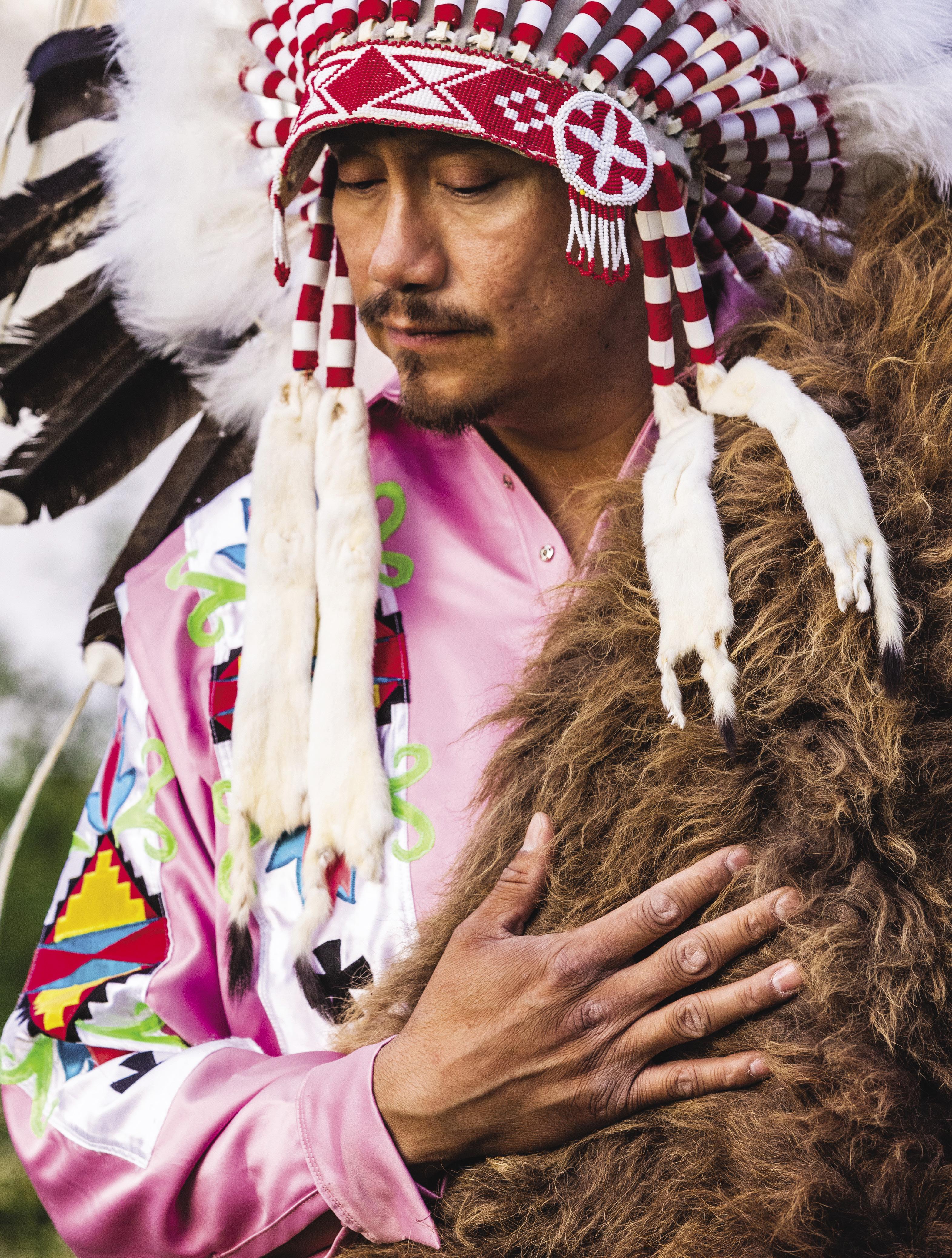
17
“WE ARE SO RECIPROCAL IN OUR THINKING THAT I IMAGINED THE HERD KNEW WE WOULD DO SOMETHING GOOD WITH HER AND THAT IT WOULD COME BACK TO THEM. AND LOOK AT ALL SHE’S
Marni Hope, the college’s Indigenous student support and events coordinator, says the experience of creating a Winter Count Robe for campus was a chance to connect with her roots. “Any time we get the opportunity to go back to our ways, it builds self-esteem and connection to the territory,” she adds.
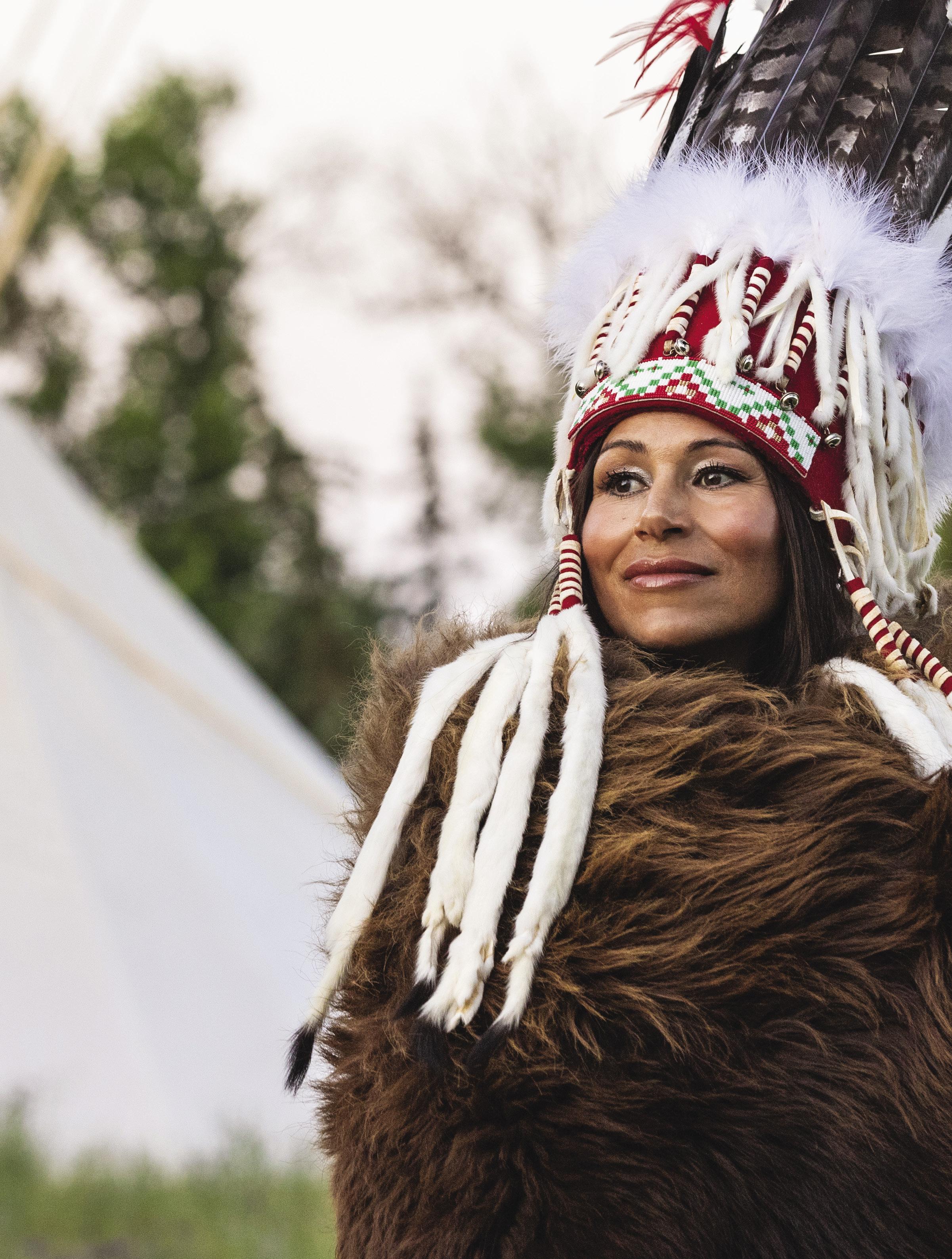
GIVEN US.”
18 | FALL 2023
MARNI HOPE MIISOMII’KITSIKAAKII / LONG TIME OFFERING
Acquiring a buffalo robe for Lethbridge College was something the Indigenous Services team had been considering long before connecting with the Piikani Nation in late 2022. The idea initially stemmed from their participation in the McConnell Foundation’s Social Innovation Lab on Reconciliation in the Postsecondary Education Sector.
Lethbridge College and Algoma University in Ontario were the only two postsecondary institutions to take part in the pilot project, which launched in the fall of 2021. Each regional team was asked to tackle a specific opportunity facing them in their efforts for reconciliation.
For the Lethbridge group, lab sessions incorporated both Blackfoot worldviews and western worldviews, as members worked to identify opportunities to incorporate Indigenous ways of knowing into curriculum and a method and practice for teaching adult learners. Out of that approach came a focus on preserving Indigenous culture and language – specifically the Blackfoot language.
As part of the process, members of the college community came together, including Provost and Vice President – Academic Dr. Samantha Lenci; members of the Indigenous Services team; and other college colleagues, including Kristen DeMone, who had been part of the social innovation lab experience. Their work was focused on reconciliation, and as part of that, they visited Blackfoot Crossing Historical Park and Old Sun College on Siksika Nation as well as Red Crow College on Kainai Nation. In their travels, they noticed a theme – all had Winter Count Robes telling their stories.
“We noted during the lab, that in order to have reconciliation, you have to go back and reflect on the truth,” says Yellowhorn. “As an educational institution for several frontline workers including police, nurses and child and youth care specialists, we have to look at some hard truths – what was our role in the colonization process and how are we going to address it and fix it.”
Wanting the college to be a catalyst for change, the Indigenous Services team felt a Winter Count Robe would not only be a prominent symbol of traditional Blackfoot Territory on campus, but it would also reaffirm the close relationship between the college and Indigenous communities in southern Alberta –specifically the Piikani and Kainai First Nations.
“They are two of the largest partners in this institution,” explains Yellowhorn. “The education people receive here is driving those communities and leading the way for Indigenous communities across Canada.”
As a result of that longstanding relationship, the college was given the opportunity to harvest a buffalo from the Piikani herd and to use the hide for a Winter Count. After consultations with the college’s Executive Leadership Team, Yellowhorn made the arrangements.
For Yellowhorn and Hope, the hunt was a chance to connect with their roots, to feel even deeper that sacred relationship from centuries past when buffalo were essential to life – providing food, clothing and shelter for entire tribes.
“We did it in a culturally appropriate way,” Yellowhorn says. “We sat down, and we engaged in ceremony with the cultural community. Cultural practitioners, elders, and some key influential grandfathers from the Blackfoot Confederacy were there guiding us, and we had their blessing to harvest the animal.”

19
Yellowhorn offered the Lethbridge College pipe to an elder and spoke in the Blackfoot language. He asked him to pray for the Blackfoot people and for the college, and to ensure the hunting party was moving forward in a good way. Yellowhorn says he also emphasized the importance of the buffalo robe to the Indigenous community at Lethbridge College.
“It’s about representation for our students and creating a safe place,” he says. “You may think ‘well it’s just one Indigenous student’ but that student could have 15 people relying on him or her to get an education and provide for the family. These types of decisions save lives.”
“Sharing those cultural stories and land-based learning skills are an important part of our identity as Blackfoot people,” adds Hope. “We have an identity crisis because of colonization, so any time we get the opportunity to go back to our ways, it builds self-esteem and connection to the territory.”
Joining Yellowhorn, Hope and Kainai Kaahsinnoonik (grandparent) Peter Weasel Moccasin (Miiniipooka/Berry Child) from Lethbridge College was Dr. Terry Kowalchuk, Dean of the Centre for Technology, Environment and Design. He was personally invited by Yellowhorn, and was the only non-Indigenous member in the group of 20 or more people.
“I’ve hunted, fished, trapped and lived off the land my entire life,” says Kowalchuk, “but when Lowell asked me to join him and a party of Blackfoot hunters, it was very special.”

Kowalchuk wasn’t only there to observe. With years of experience field dressing large animals, he took the lead when the time came, and shared his knowledge with the others as they moved through the process.
“We were all there to listen,” says Hope. “Terry was such a part of it all, even though he was the only non-Indigenous person there, it didn’t matter. He had things to share and to teach us and it almost felt like he was an honorary member in that moment.”
With several young men from Piikani Nation also eager to assist, Kowalchuk turned over his knife and guided them as they helped process the buffalo.
“We didn’t want to cut the hide too much, but we also recognize we are a learning institution,” says Kowalchuk. “Sometimes little mistakes are made in the process and when you see the hide, there’s a few nicks and holes and that’s OK –that’s us, that’s our story.”
The learning continued back at Lethbridge College as Culinary students, in both diploma and apprenticeship programs, broke down the carcass into steak, roast, ground, stew and stir-fry cuts. The meat was packaged into small one-kilogram bags and given back to the Piikani Nation for distribution through the local food bank.
“That’s reciprocity,” says Yellowhorn. “We came back together to deliver the successes of the hunt and engage in ceremony. It was a sacred protocol that reaffirmed the relationship between the college and Piikani Nation.”
Kowalchuk, meanwhile, spent 10 hours or more fleshing the buffalo hide (scraping away any remaining tissue) at his home workshop before bringing it to the college’s necropsy lab in the School of Environmental Sciences. That’s where student and employee volunteers helped prepare the hide for preservation.
20 | FALL 2023
“THAT’S RECIPROCITY. WE CAME BACK TOGETHER TO DELIVER THE SUCCESSES OF THE HUNT AND ENGAGE IN CEREMONY. IT WAS A SACRED PROTOCOL THAT REAFFIRMED THE RELATIONSHIP BETWEEN THE COLLEGE AND PIIKANI NATION.”
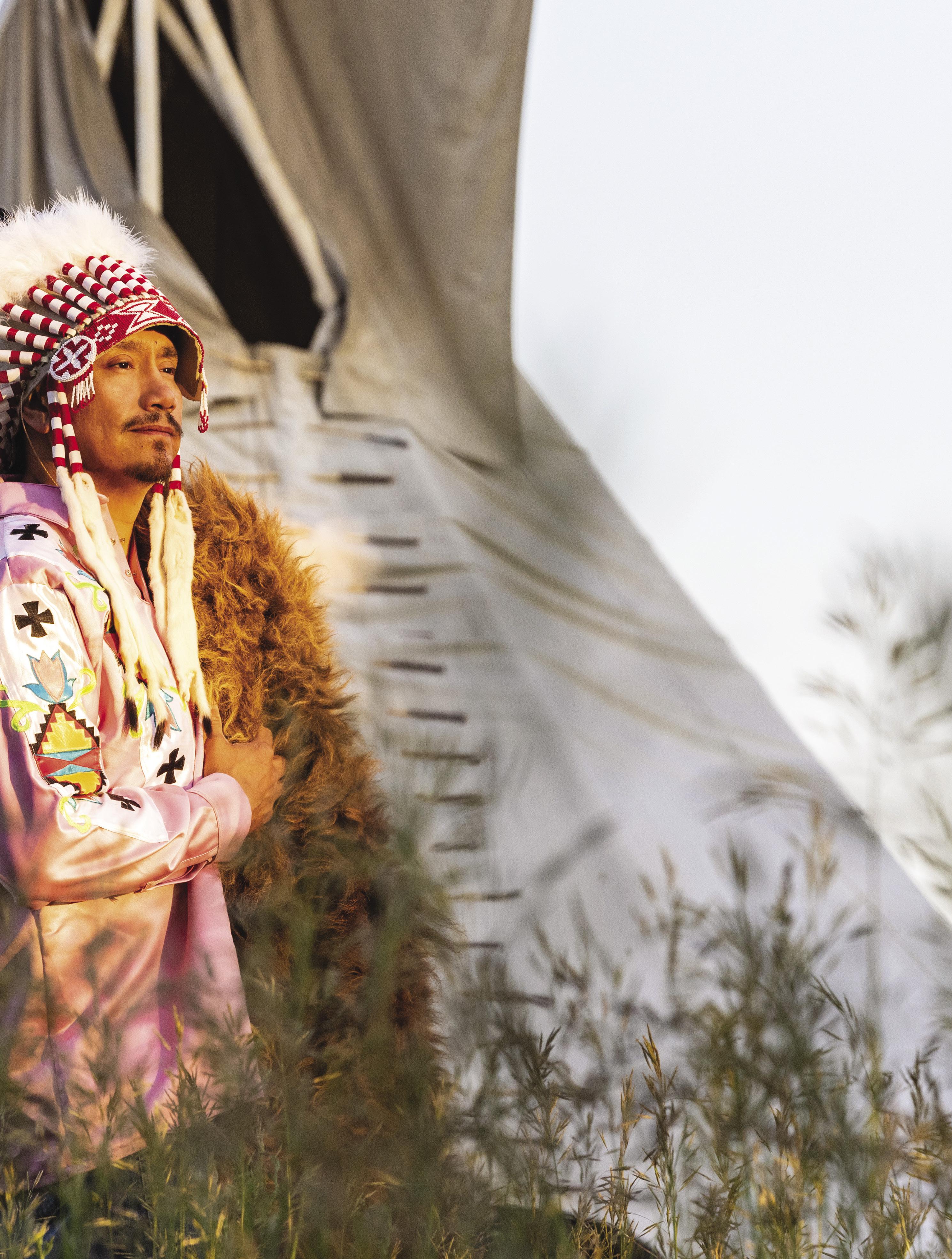 LOWELL YELLOWHORN SPIITAWAKASI / TALL DEER
LOWELL YELLOWHORN SPIITAWAKASI / TALL DEER
21
Lowell Yellowhorn, the college’s Indigenous Services manager, was among those who proposed creating a Winter Count Robe as one way the college could be a catalyst for change when it comes to reconciliation.
“AS A BIOLOGIST WHO IS PROFESSIONALLY TRAINED TO UNDERSTAND THE RELATIONSHIPS BETWEEN LIVING THINGS, AND AS SOMEONE WHO HAS GROWN UP IMMERSED IN NATURE, THIS WAS THE OTHER PIECE. ...IT WAS SPIRITUAL AND IT WAS ONCE IN A LIFETIME.”
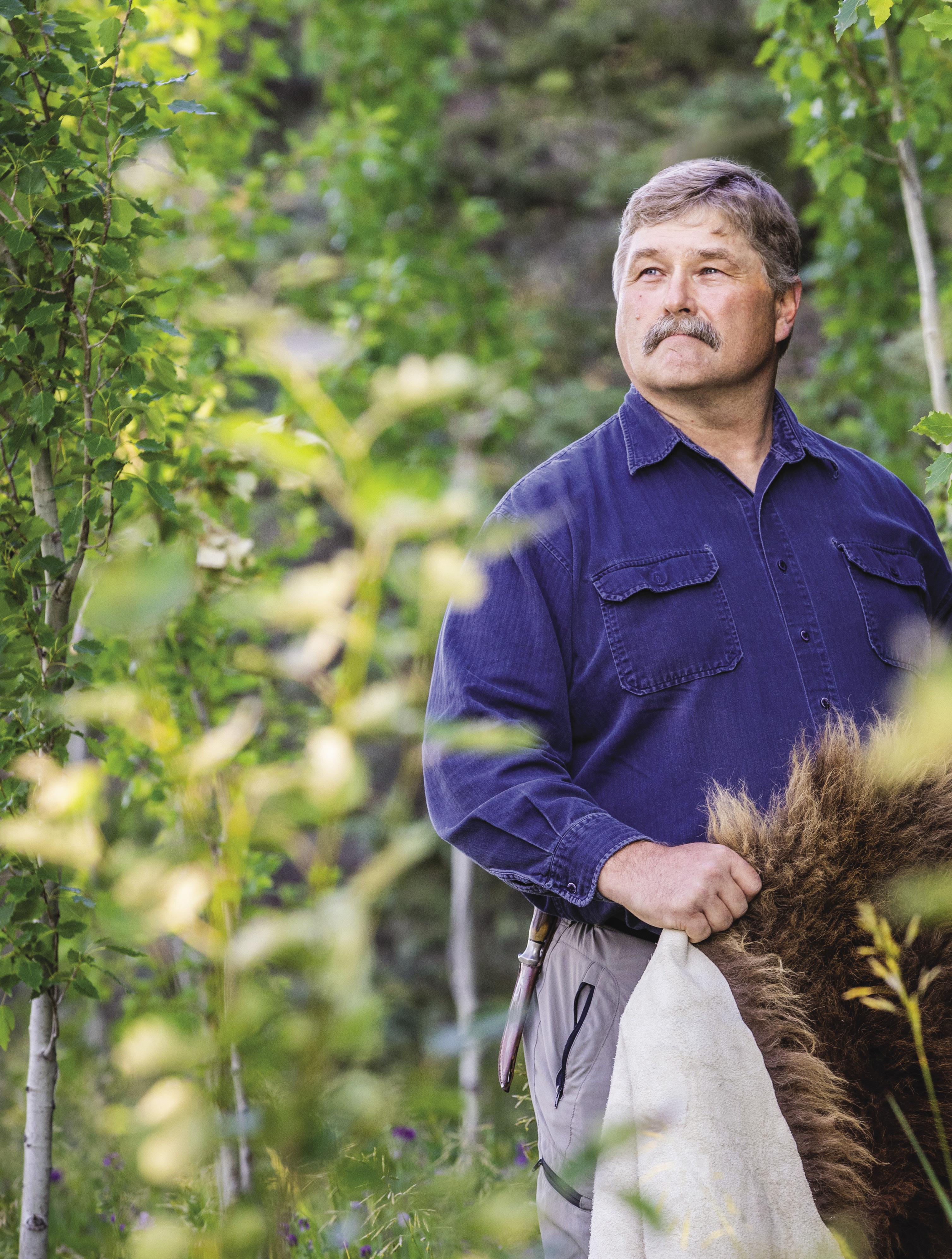 DR. TERRY KOWALCHUK
DR. TERRY KOWALCHUK
22 | FALL 2023
Dr. Terry Kowalchuk, Dean of the Centre for Technology, Environment and Design, says the experience of bringing the Winter Count Robe to campus has been a highlight of both his professional and his hunting careers.
Part of the tanning process also involves “working” the hide as it dries, which breaks up the fibrous sinew so it doesn’t harden. It’s an essential but demanding job. Volunteers took turns over several days, pulling the hide back and forth over a beam – an activity that caught the attention of a passing student.
“My buddy Adam (Pasowisty) and I were walking the halls between classes one day, and I noticed some people breaking-in a buffalo hide,” says Scott Braun, Natural Resource Compliance student. “I’ve tanned a couple of animal hides myself, and Adam is getting into it, so we asked if we could watch.”
Braun says he shared some of his experiences with the group and suggested an alternate method of tanning – to rub a fine grit rock over the leather side of the hide. He touched base a few days later and was told his advice had “worked perfectly.”
“I grew up in Grande Prairie hunting and fishing, and I believe in honouring the animal to its fullest extent by using everything you can, including the hide,” says Braun. “It means a lot to me that I was able to help out and share a skill that’s been lost by a lot of hunters. I hope more people are encouraged to get back to that tradition.”
At the end of the tanning process, when the hide was ready to tell the college’s story, the robe was handed over to Blackfoot artist William Singer III (Api’soomaahka/Running Coyote) to paint the Winter Count.
The robe will be on permanent display in the Trades, Technologies and Innovation Facility and will be featured prominently at several annual campus events including convocation, Stone Pipe Days, the Ohkotoki’aahkkoiyiiniimaan Powwow and more. (Read about Singer’s work on page 24.)
“It’s inspirational,” says Yellowhorn. “It may look like simple art when you see it, but it’s meaningful and it instills pride. And when my grandkids and greatgrandkids ask, I can step up and say, ‘this is what we did; this was part of our reconciliation process.’”
Kowalchuk says the experience – from start to finish – has not only been the highlight of his time at Lethbridge College, but the highlight of his entire hunting career. “As a biologist who is professionally trained to understand the relationships between living things, and as someone who has grown up immersed in nature, this was the other piece,” he says. “I was invited by someone I respect, to play an active role and to be part of a true hunter-gatherer society. It was spiritual and it was once in a lifetime.”

Hope says she still feels a deep connection to the buffalo and wants to ensure the robe makes its way back to Piikani from time to time. She also hopes to share its story with students, employees and community members as often as possible. “It’s really an opportunity to teach,” she says. “Maybe it encourages a student to ask more questions about the ceremony or why it’s significant. It can open the door for further discussion.”
Yellowhorn agrees. “We need to keep asking questions. Just like the path of the buffalo, it won’t be a straight line. But we’re all on this journey together.”
23
THE STORY OF LETHBRIDGE COLLEGE’S WINTER COUNT ROBE
A GIFT OF THE IINII
This fall, Lethbridge College will unveil its traditional Buffalo Winter Count Robe to the community – likely in late September as part of events surrounding the National Day for Truth and Reconciliation. The robe will be used as a teaching tool, to record major college events, and as a sign of the college’s ongoing work to understand and honour traditional cultures and ways of knowing.

“Winter Counts were created and are still created as a way of communicating, of transferring knowledge,” says Kainai Knowledge Keeper and artist William Singer III (Api’soomaahka/Running Coyote). “Looking at a history, this robe tells the story of the college. It’s for teaching as well. Some of the symbols are straightforward. Others have different meanings. And there are also elements where you have to take action. Each symbol has a story, and they all fit into each other and form a chain until the end, and once you fill up a hide, you start another. There is space left on the college’s winter count so the story can be added to.”
Singer says the robe reflects not just the art of the symbols, but also science and technology. “Our language, whether written with symbols or in syllabic form, is the basis for the development of the science and the technology that the land gives,” he explains. “When talking about the Winter Count and Blackfoot language, both are recognized as forms of science. It also took a lot of science and technology from the students and those who helped create this robe. In this case, a lot of different hands and hearts and thoughts went into this, and got the hide ready to be painted.”
24 | FALL 2023
Story by Lisa Kozleski | Photos by Rob Olson

25
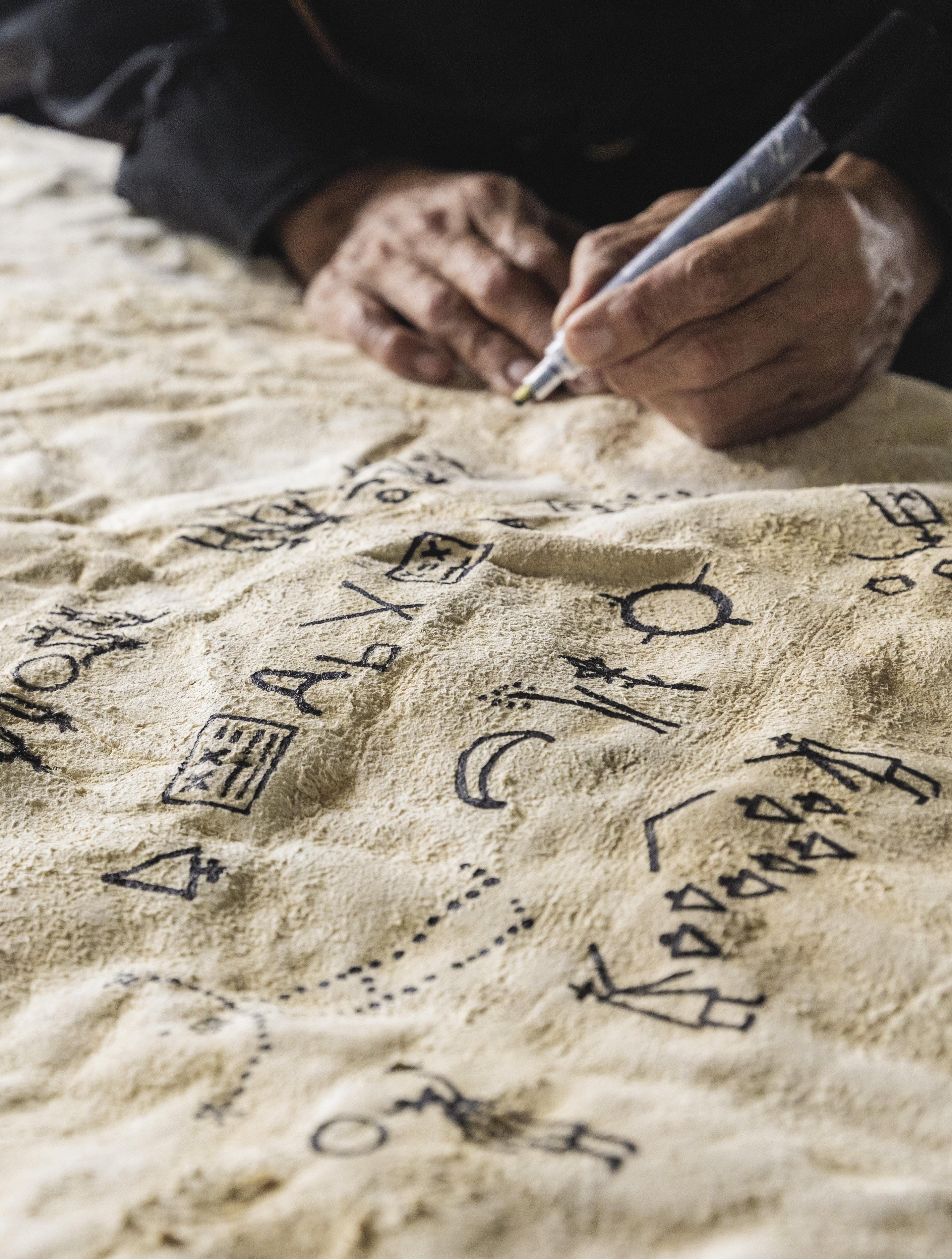
26 | FALL 2023
Kainai Knowledge Keeper and artist William Singer III (Api’soomaahka/ Running Coyote) painted the college’s Winter Count Robe in the spring of 2023.
What is a Winter Count?
A Winter Count is a pictorial calendar or history painted on a buffalo hide created by many Northern Great Plains First Nations that carries the story of a community. Traditionally, each nation would choose a single keeper of the winter count; each year, at the first snowfall, the keeper would consult with elders to reach a consensus for choosing a name and pictograph for the year, and then would add that image to the robe. These Winter Counts Robes were used as guideposts in transmitting oral tradition and history. Lethbridge College’s traditional Winter Count Robe, which is expected to be brought to campus in September, will be used to share the college’s history with its community, from the land where it was built, to its foundation in 1957, through to today, and for seasons to come.
Where did Lethbridge College’s buffalo robe come from?

The idea of Lethbridge College acquiring a Winter Count Robe stemmed from the college’s participation in the McConnell Foundation’s Social Innovation Lab on Reconciliation in the Post-secondary Sector. Wanting the college to be a catalyst for change, the Indigenous Services team felt a Winter Count Robe would not only be a prominent symbol of traditional Blackfoot Territory on campus, but it would also reaffirm the close relationship between the college and Indigenous communities in southern Alberta –specifically the Piikani and Kainai First Nations. Please see the story written by Tina Karst on page 16 to learn rest of the story of how the robe came to be at Lethbridge College.
How will Lethbridge College use its traditional Winter Count Robe?
The traditional Winter Count Robe will typically be displayed on campus starting this fall. However, it will be placed in a portable showcase so that it can be transported to other areas to be used in different ceremonial events, including convocation, or to classrooms and other campus spaces to be used as a learning tool for students, community members and friends of the college.
Why did the college choose to have a robe created?
The creation of the robe and commitment to using it as a teaching tool and to record major college events are signs of the college’s ongoing work to understand and honour traditional cultures and ways of knowing. It is also a way for the college to lead in implementing the recommendations of the Truth and Reconciliation Commission. Lethbridge College’s traditional Winter Count Robe will serve as a visual reminder that the college’s history and the history of the Siksikaitsitapi (Blackfoot Confederacy) are indelibly linked.
What are some of the elements incorporated into the story of Lethbridge College’s Winter Count Robe?
Some of the elements painted on the robe include: the Creation story; first contact between Blackfoot people and colonizers (early 1700s); signing of the Lamebull Treaty (1855); signing of Treaty Seven (1877); the opening of the first residential schools (1893); ending of the pass system (1951); the opening of Lethbridge Junior College (1957); the beginning of the Sixties Scoop; first Indigenous students graduate (1960s); name changed to Lethbridge Community College (1967); Native Advisory Council starts (early 1970s); First Indigenous member of the Board of Governors – Marvin Fox (1970s); First Native Student Club (1970s); Indigenous Services start (1979); Piitapawani Student Lounge opens (1980s); last Residential School closes (1996); and much more.
27
Who created the college’s traditional Buffalo Winter Count Robe?
Kainai Knowledge Keeper and artist William Singer III (Api’soomaahka/Running Coyote) painted Lethbridge College’s robe in the spring and summer of 2023. Colleagues from departments across campus (including Indigenous Services, Communications, Marketing, Student Affairs, and Executive Leadership) came together with Kainai Kaahsinnoonik (Grandparent) Peter Weasel Moccasin (Miiniipooka/Berry Child) to create the list of events to be included in Lethbridge College’s robe.
Singer is a member of the Kainai First Nation. He was named after his great uncle Running Coyote, a Blackfoot warrior who, in his later years, created pictograph art for elder warriors who wanted their stories saved for future generations. Knowing this, Singer said it is his duty to carry on his namesake’s legacy by surviving in two worlds and maintaining the Blackfoot worldview. Singer’s main profession is as an artist/illustrator with 40 years of experience, and his work is deeply rooted in the Blackfoot worldview. Along with his art, Singer is a dedicated entrepreneur and an environmental and political activist who uses Blackfoot ecological knowledge and protocol in his work. He also works in areas such as food security and sovereignty, Blackfoot science and physics, watershed health, and grassland restoration. Singer has been involved in many spiritual, cultural events and activities and has always been an advocate for First Nations rights, knowledge and wellness. Singer is well known to the Blood Tribe community for being a knowledge keeper and issksinímayi of traditional plants and their uses. He looks to the outdoors as the ideal classroom for learning Niitsitapiipaitapiiwahsini – the Niitsitapi Way of Life. He also operates Naapi’s Garden and Katoyiss Seed Bank.
What about some other collaborations between Singer and the college?
Singer started collaborating with the college in 2017. His first project was creating a special painting for Founders’ Square, which was built as a way of commemorating Lethbridge College’s 60th anniversary. The next major project Singer worked on was in 2020, when he helped create an online tour of the traditional plants found in the coulees behind campus, a resource that is now shared by students, alumni, employees and friends of the college. That project launched a related one – the creation of the Iissksiniip Coulee Walk, which opened in fall 2021. The Iissksiniip Coulee Walk is an interpretative selfguided tour found on the west edge of campus that explores the traditional plants found in the area, explains their uses and shares some of the traditional creation stories of the Siksikaitsitapi, the Blackfoot Confederacy. Most recently, Singer has been working on creating the story on the college’s Winter Count Robe.

What was the process of creating the robe like for Singer?
Singer explains: “Whenever I work on it, I always have good thoughts. I think of the history of the college and how far they’ve come and how much is happening within the community right now. I think about the students at the school and the individuals who have worked or handled this hide itself, and I feel that – I feel all that energy on the hide. I think of a lot of things to prepare myself to get into the good thoughts and good spirits needed to create this Winter Count.”
28 | FALL 2023
Singer says he would make sure he had good thoughts in his mind and heart – including thoughts of all of the students at Lethbridge College – before adding more drawings to the Winter Count Robe.
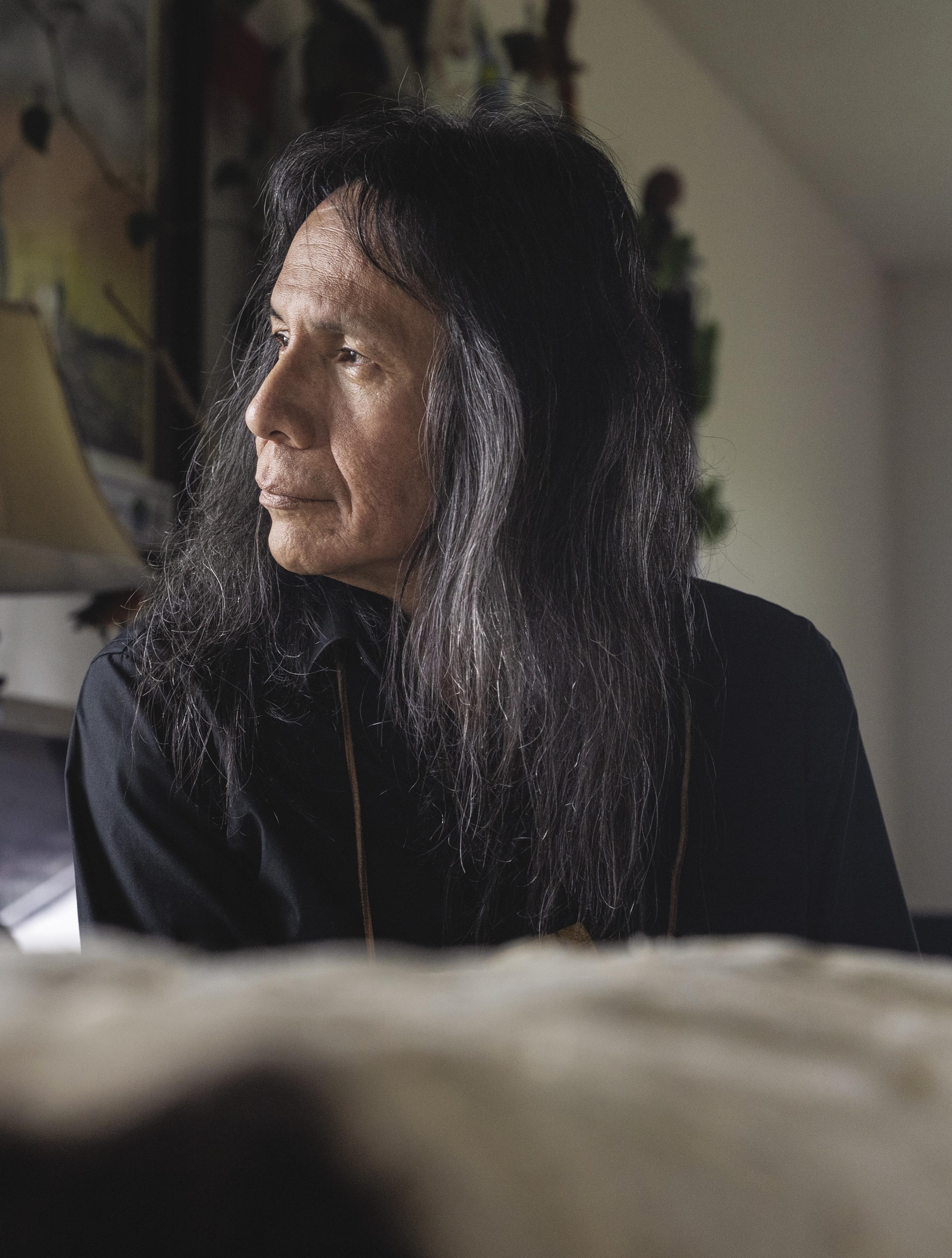
29
HISTORIC BUFFALO TREATY SIGNED AT LETHBRIDGE COLLEGE
LIVING TOGETHER WITH THE IINII
As an important step showing its commitment to being a leader in reconciliation, hundreds of members of the Lethbridge College community witnessed the signing of the Buffalo Treaty in March at a ceremony that kicked off the college’s annual Stone Pipe Days celebration.
Lethbridge College was the first Canadian college to sign the treaty, which was created to honour, recognize and revitalize the time immemorial relationship Indigenous people have with the buffalo (iinii), and to commit to working so that people and buffalo will once again live together to nurture each other culturally and spiritually. The treaty was first signed in 2014 by four First Nations in Canada and four Indigenous tribes in the United States on the Blackfeet Reservation near Browning, Mont., and it was the first treaty signed among First Nations in more than 100 years.
“The signing of this treaty is an historic opportunity for the college to showcase its leadership in reconciliation,” says Lowell Yellowhorn (Spiitawakasi/Tall Deer),
Lethbridge College’s Indigenous Services manager. “In leaving our names on this document as witnesses to this agreement, we are committing to building relationships with other signatories and working alongside them in pursuit of a common – and important – goal.”
“IN SIGNING THE TREATY, WE ARE COMMITTING TO TRANSFERRING KNOWLEDGE, DEVELOPING PROGRAMS, AND PERPETUATING KNOWLEDGEGATHERING AND KNOWLEDGESHARING TO YOUNGER GENERATIONS.”
DR. BRAD DONALDSON LETHBRIDGE COLLEGE PRESIDENT AND CEO
30 | FALL 2023
Story by Lisa Kozleski | Photos by Jamin Heller

31
Dr. Leroy Little Bear (right) indicates to Lethbridge College President and CEO Dr. Brad Donaldson where to sign his name on the Buffalo Treaty in March at Lethbridge College.
The event drew hundreds of students, employees, alumni and community members to the gym, where they were treated to an historic overview of the treaty by Dr. Leroy Little Bear (Iikaisskini/Low Horn), one of Canada’s most respected Indigenous academic voices. He is also the Vice-Provost, Iniskim Indigenous Relations at the University of Lethbridge, was made an Officer of the Order of Canada in 2019, and was awarded the Alberta Order of Excellence in 2016. “The signing by Lethbridge College is a fantastic cause for celebration,” says Little Bear. “When we see others joining, it’s very fulfilling.”
At the end of the ceremony, in an act many described as powerful and full of meaning, each person added their names to the treaty, waiting patiently for nearly an hour, in two lines that stretched across the gym.
“These are the moments when we weave together traditional knowledge and learning with the future direction of the college,” says Dr. Samantha Lenci, Lethbridge College’s Provost and Vice President – Academic. “Signing our names, as individuals and as a community, is a way of recognizing both where we are and who we want to be.”
Lenci adds that the signing of the treaty fits well into the promise that was made when the college received its Blackfoot name Ohkotoki’aahkkoiyiiniimaan, which means Stone Pipe, in 2017. “The offering of a stone pipe is a promise or a peace bond made with the honesty and integrity needed to fulfil the commitment,” she says. “It reflects our promise and commitment to our students, our college community and all Indigenous communities. We understand that our name comes with a responsibility, and every day, we try to live up to that promise and commitment.”

Two articles of the treaty are especially important to the work happening at Lethbridge College – Article V (Education) and Article VI (Research). Lethbridge College President and CEO Dr. Brad Donaldson explains that coming together during Stone Pipe Days celebration and being the first Canadian college to sign this historic treaty is one way the college community can show its ongoing commitment to realizing the buffalo ways for future generations. “In signing the treaty,” he says, “we are committing to transferring knowledge, developing programs, and perpetuating knowledge-gathering and knowledge-sharing to younger generations.”
At the end of the event, hundreds of students, employees, alumni and friends of the college had added their names to the treaty as witnesses – the original of which can be viewed at Whyte Museum of the Canadian Rockies Archive and Library. Learn more about the treaty at buffalotreaty.com.
Dr. Little Bear, one of Canada’s most respected Indigenous academic voices, is leading the effort to educate communities about buffalo and the Buffalo Treaty.
32 | FALL 2023
EXCERPTS FROM THE BUFFALO TREATY
Creator gave us many gifts and teachings to survive this world. One of those teachings is everything is interrelated. In the Indian practice, the interrelated world is realized through Treaty-making with all my relations.
RELATIONSHIP TO BUFFALO
Since time immemorial, hundreds of generations of the first peoples of the First Nations of North America have come and gone since before and after the melting of the glaciers that covered North America. For those generations, buffalo has been our relative. Buffalo is part of us and we are part of buffalo culturally, materially and spiritually. Our ongoing relationship is so close and so embodied in us that Buffalo is the essence of our holistic eco-cultural life-ways.
ARTICLE V – EDUCATION
Recognizing and continuing to embody all the teaching we have received from buffalo, we, collectively, agree to develop programs revolving around buffalo as a means of transferring intergenerational knowledge to the younger and future generations and sharing knowledge amongst our respective nations.
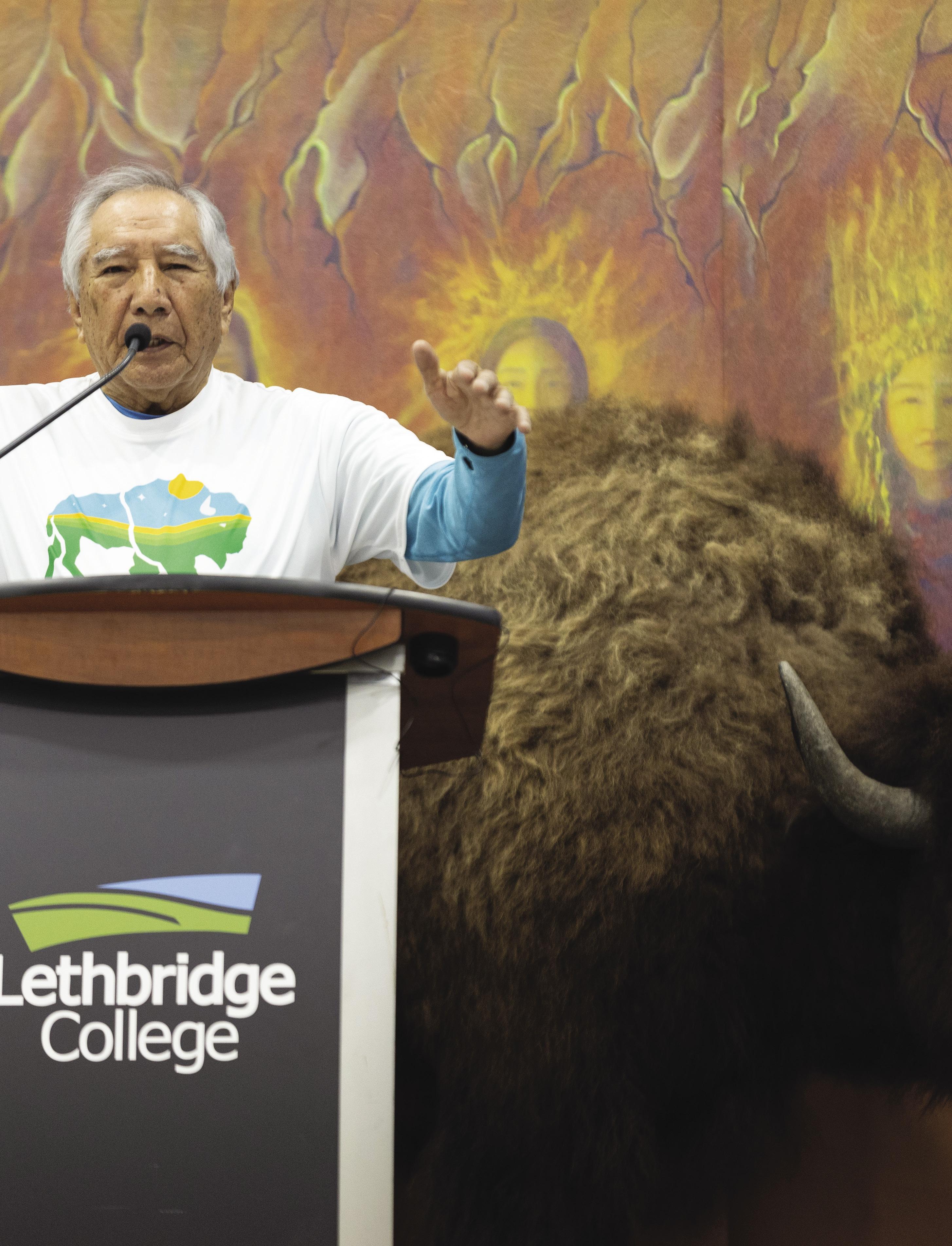
ARTICLE VI – RESEARCH
Realizing that learning is a life-long process, we, collectively, agree to perpetuate knowledge-gathering and knowledge-sharing according to our customs and inherent authorities revolving around buffalo that do not violate our traditional ethical standards as a means to expand our knowledge base regarding the environment, wildlife, plant life, water, and the role buffalo played in the history, spiritual, economic, and social life of our nations.
LEARN MORE AT BUFFALOTREATY.COM
33
THREE STORIES OF THE IINII
VISIT
WIDERHORIZONS.CA FOR MORE
Including a reflection on the iinii from Dalyce Gladstone (Naato Piita), a 2023 graduate of the Bachelor of Ecosystem Management program.
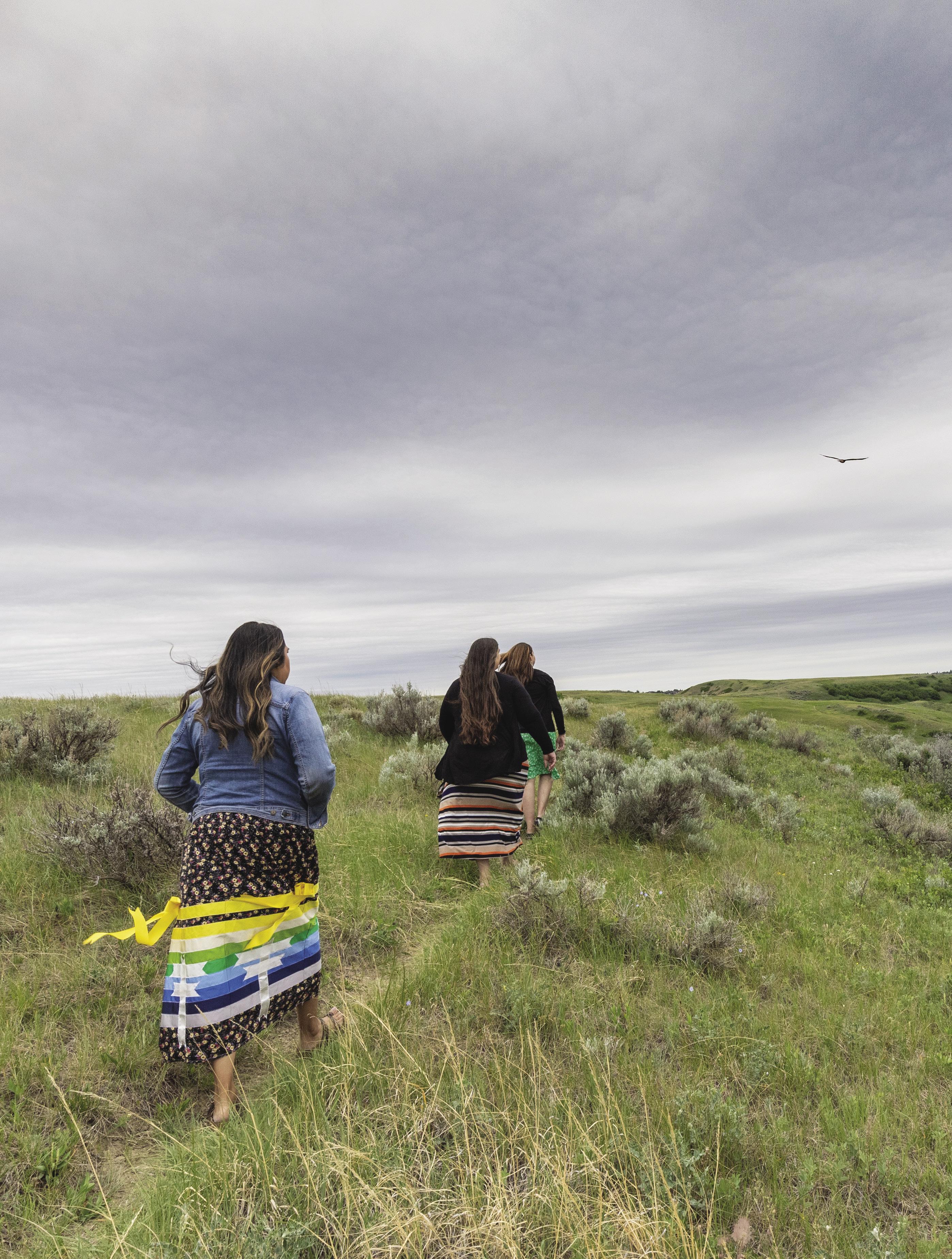
34 | FALL 2023
LETHBRIDGE COLLEGE INSTRUCTORS SHARE
AAPISTAMIKIITSINIKSSI * (BUFFALO STORIES)
When Peter Weasel Moccasin (Miiniipooka/Berry Child) was a little boy, in the days before he was sent away to residential school, when his family didn’t have the things people have today – television or electricity – his father would keep the house warm at night with the woodstove, carrying a kerosene lamp, and on many nights, he would tell his son a story.
“Winter nights were long nights,” Weasel Moccasin remembers. “I was just four and five and six, and used to sleep on a mattress on the floor. And some nights, my dad would call to me, he would say ‘My son, are you awake?’ And I would say ‘Yes, I am awake.’ And then he would tell me a story, a legend of the past. Even when I left for residential schools, when I would come home, he would still share with me these stories.”
All of those stories his father told him were connected, Weasel Moccasin explains, and were the same stories his father had heard from his father before him. While the topics and focus changed each night, they all provided lessons on the connections between people and the challenges they faced, and the world they lived in.
“He didn’t give me answers,” Weasel Moccasin says. “He said the answers are in the stories.
He wanted me to understand. And when I started to have grandchildren, he said to me, ‘I told you a number of stories, a lot of stories. Do you remember them?’ I said, ‘Yes, I remember them.’ Then he said to me, ‘So how did you understand them? What did you learn from them? How did you figure out anything from them? How are you going to handle your life? How are you going to choose the path in your life?’ ”
The sharing of stories, Weasel Moccasin says, can provide a wealth of different lessons at various points in a person’s life. One story can provide guidance to a person one year, and reassure that same person a decade down the road. Sharing a story is one of the best ways to teach, and listening to a story is one of the best ways to learn.
In this storytelling spirit, the Wider Horizons team asked three instructors in the Centre for Business, Arts and Sciences to share three stories of buffalo, and some lessons they have learned. Here’s what they had to say.
*With great thanks and warm appreciation to Aanatsoyi’kayaakii Alvine Mountain Horse for providing the Blackfoot translation of “Buffalo Stories.”
35
Introduction by Lisa Kozleski | Photos by Rob Olson Stories by Sandra Bartlett Atwood, Marcia Black Water and Jessica Fox
A BUFFALO HARVEST
BY SANDRA BARTLETT ATWOOD INSTRUCTOR IN INDIGENOUS STUDIES
CENTRE FOR BUSINESS, ARTS AND SCIENCES
M any students here at the college have mentioned to me that they didn’t know that Blackfoot culture is a living culture. They see Blackfoot people (Niitsitapi) engaging in modern professions like nursing, policing, agriculture, social work, business management, education, construction and others, and assume that their culture is preserved as history, a memory, rather than an ongoing way of life.
Recently I was invited to a buffalo (iinii) harvest, where I got to see first-hand just how alive Niitsitapi culture is today. Several families gathered together and made camp. One individual who had been transferred the right to kill or capture iinii was selected to take the animal, which is expected to be done with only one shot. From a distance, I witnessed one iinii from the herd step forward and offer itself just as I had been told would happen. This animal was treated with the respect and care of a beloved relative who had given their life so that others might live and, in this case, learn too.
This particular harvest was meant to pass this knowledge on to future generations. The Elders and students made tobacco offerings and prayed, thanking their brother for helping them preserve their culture. I was told that every part of iinii had been vowed for ahead of time. I was also instructed that they only had about three hours to harvest the meat and especially the intestines for them to be usable.
I come from a long line of avid hunters, yet I had never seen anyone harvest the intestines, spleen, and stomach of an animal before. The hooves would
be used for rattles, the robe was to be tanned, the tongue would be used for a holy soup at a later ceremony.
I watched in delight and wonder as one little girl tenderly clutched the one-gallon bucket that contained iinii’s heart, for hours, walking it around to show others and smiling with pride to have the privilege of such an honourable task.
I observed another young woman being taught by her mother who had the rights to harvest organs and entrails. She couldn’t have been more than 10 years old and yet she confidently and humbly laid out the intestines down a shallow slope in the grassy field and then squeezed her fingers across them to empty their contents at the bottom of the slope. She then ran water through them and repeated the process until they were clean.
Some older boys had been transferred the right to put a knife to the animal and harvest the meat. This too was done methodically and respectfully. Sinews were carefully removed from the back strap and everyone got to take home some of the meat. Throughout the day, an Elder was teaching the Blackfoot words for the parts of the buffalo and the processes involved in the harvest.
I’ve been told that in the Blackfoot language there are no words for the past and future tense, only the present. Indeed, that day, time seemed to stand still. The past, present and future existed together as the ancestors smiled on us for maintaining the treaty Niitsitapi have made and renewed with iinii since time immemorial.
36 | FALL 2023
“THE PAST, PRESENT AND FUTURE EXISTED TOGETHER AS THE ANCESTORS SMILED ON US FOR MAINTAINING THE TREATY NIITSITAPI HAVE MADE AND RENEWED WITH IINII SINCE TIME IMMEMORIAL.”

37
SANDRA BARTLETT ATWOOD
“...I FELT A SOFT WIND, AND EVERYTHING GOT QUIET. THE IINII BULL GOT SO CLOSE THAT, IF I WANTED, I COULD HAVE TOUCHED THE FURRED CROWN OF ITS HEAD. I WATCHED INTENSELY AS IT BOWED THREE TIMES, SAT ON THE FOURTH BOW, AND I SAT DOWN ON THE BOARD WALK.”
MARCIA BLACK WATER IITO’TAAWAOHKAAKII
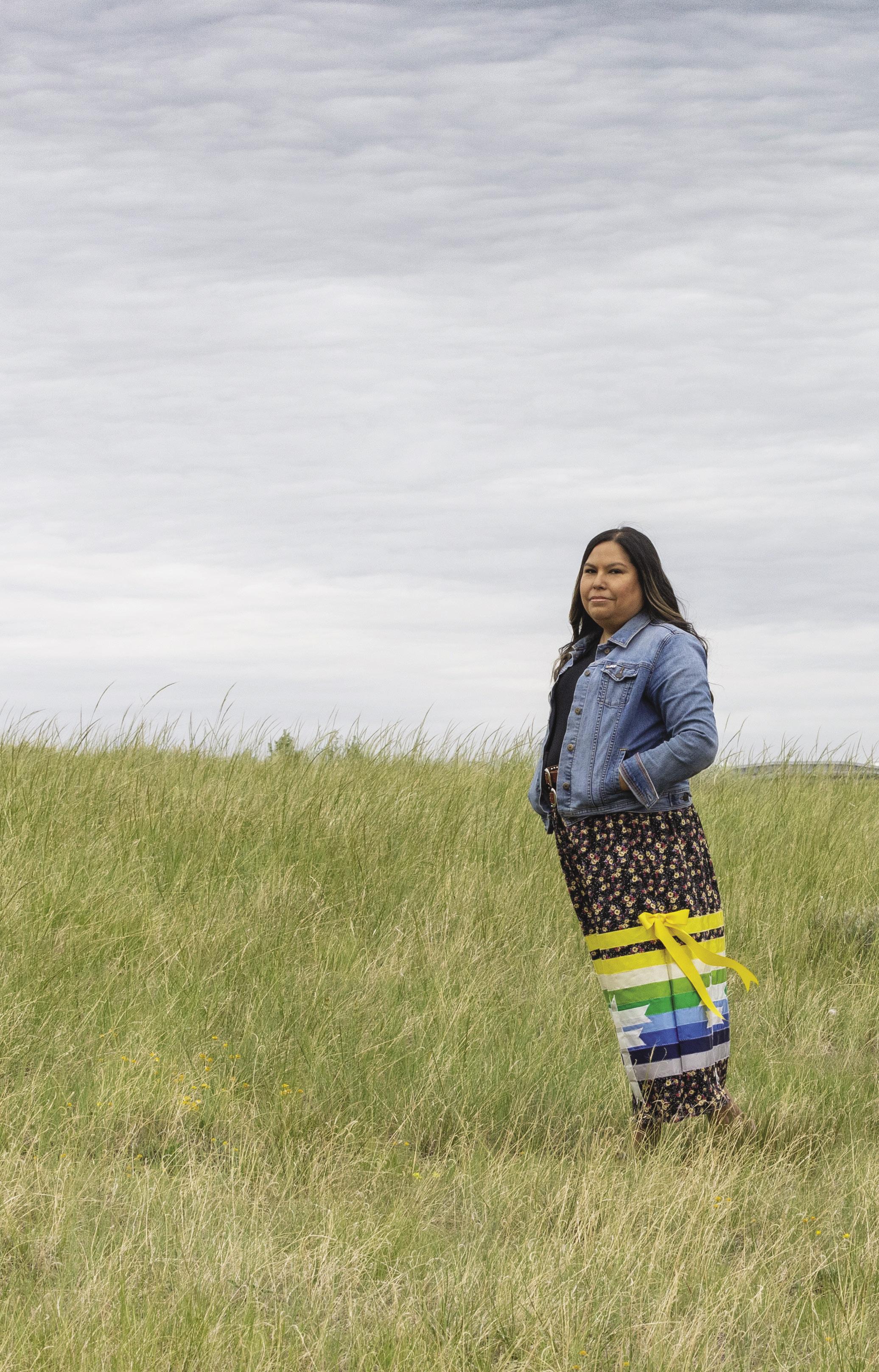
38 | FALL 2023
/ WALKING BESIDE
FOUR IINII BULLS
BY MARCIA BLACK WATER ( IITO’TAAWAOHKAAKII / WALKING BESIDE)
(GENERAL STUDIES 2004) - INDIGENOUS COORDINATOR AND INSTRUCTOR CENTRE FOR BUSINESS, ARTS AND SCIENCES
When I was a young child, I had a dream that had me wake up, still hearing the wind in my ears, feeling the cold of an impending spring storm and the sound of hooves grinding as they walked on gravel.
In my vivid recall of this dream, I am walking in an open field getting to a near gravel road. As I got to the road, I could feel a vibration of a stampede of animals approaching from the east – they were iinii (buffalo). The iinii came thundering by, stopped behind me and I turned to see them standing. From the herd, four iinii walked forward, stood on their hind legs, and began to sway back and forth. I calmly swayed back and forth in mirrored fashion. The hooves of the herd scraping at the gravel rocks sounded like a raw-hide rattle. I awoke.
I think about this dream in moments of references to iinii as the missing species in the Plains ecosystem. In June 2013, I was on a trip with Red Crow College’s Kainai Studies program; a summer course, titled Kainai’ksahko: Learning and Being in Kainai Spaces, provided the opportunity to visit the land and learn through stories from Kainai Elders. It was my first experience with landbased learning.
The course included a visit to Yellowstone National Park, this area being the south boundary of the traditional lands of the Blackfoot Confederacy.
Our course cohort had the privilege of having the late Tatsikiistamik Narcisse Blood as the instructor.
On suggestion of a man Narcisse chatted with at the gas station, we stopped at a site called Dragon’s Mouth. That day, four iinii bulls were resting at this site. The learning piece Narcisse shared with us is that the bulls stay on the perimeter of the herd, and only go into the herd when mating. While it was not my place to say much, I did notice a significance in this learning to one of our societies.
Narcisse wanted to get some pictures, so we ventured down to a boardwalk to watch the bulls closer. One iinii stood and walked toward us, and just as I began looking for safe exit points, a calm came over me, I felt a soft wind, and everything got quiet. The iinii bull got so close that, if I wanted, I could have touched the furred crown of its head. I watched intensely as it bowed three times, sat on the fourth bow, and I sat down on the boardwalk. I felt a hand on each of my shoulders. Narcisse and his son Joey began to pray. In his prayers, he made a promise that we would return to visit the iinii
As Narcisse passed in February 2015, this experience at Yellowstone has remained a great memory of my time as his student. Along with his loved ones, our community greatly felt the loss. However, he gave so much of his knowledge, so we now carry and share the teachings.
39
THE SIGNIFICANCE OF THE IINII
BY JESSICA FOX ( NATOYIIPIIKIHSA’KII / HOLY BIRD WOMAN)
ENGLISH AND INDIGENOUS LITERATURE INSTRUCTOR CENTRE FOR BUSINESS, ARTS AND SCIENCES
S hort walks around her home; tasting the sweet, wild strawberries she had just picked – the stains still fresh on her hands. Rose hips and bright coloured sunflowers; listening to the frogs sing their evening song – these memories are embedded in my mind and were the simple ways my grandmother Piiaakii strengthened my connection (Kakyosin) to the land and animals that lived near her home. When thinking about the buffalo or iinii, this connection has always been strong.
Throughout my life, Elders and family members have taught the importance of the iinii to my people, the Blackfoot. I have learned that we used every part of the buffalo - nothing was ever wasted. The buffalo was never overhunted. This is how the iinii were able to thrive for thousands of years in this place. As a child, I used to imagine what the prairies and valleys would look like filled with herds of this majestic beast. Therefore, it was a happy moment when the Kainai (Blood) tribe brought a herd of iinii back to our territory. I know that passing the herd on Highway 509 is a highlight for me and many family and friends when we travel by.
I have also been taught that in this land, where storms happen regularly - the iinii was an animal that showed its powerful spirit. When encountering a storm, rather than turning and
running away, the iinii would face the storm head on. Also, my dad talked about the incredible intelligence of buffalo when we were growing up. He had spent years around cattle and helped my uncle with his. He always said, “You have to keep cows and bulls separate, because if you don’t, they will mate at the wrong time and the calves will die if born in the cold.” Buffalo, on the other hand, naturally knew the right time to mate.
This emotional and physical strength shows just how significant the iinii were and are.
This amazing animal has shaped this land, especially in traditional Blackfoot territory. For thousands of years, the plants of our grasslands were impacted and maintained by the iinii. The iinii also directly impacted the landscape. One Elder told me and other members of my class that the trails embedded into the sides of hills were game trails. These trails were carved from years and years of animal travel – especially by the iinii.
Through these teachings and stories in my life, I have come to know the strength and significance of the iinii. As a result, when I had a chance to sign the Buffalo Treaty here at Lethbridge College, it affected me deeply. It is always a bonus to see the two distinct cultures I have grown up in, working together. I did not realize we would all be signing
40 | FALL 2023
the treaty (I thought it was just for certain people), so when I lined up, I became a little nervous. I think this was partly due to the cameras. At first, I felt indifferent due to historical let down and broken promises in First Nations treaties with the government – especially Treaty 7. However, I felt this signing was significant, and upon reflection, I am hopeful. I understand this treaty as a promise to return to the land, practices and relationships that were alive when the buffalo first roamed this land. I hope this treaty leads to change and has a positive impact on our environment.

“THIS AMAZING ANIMAL HAS SHAPED THIS LAND, ESPECIALLY IN TRADITIONAL BLACKFOOT TERRITORY. FOR THOUSANDS OF YEARS, THE PLANTS OF OUR GRASSLANDS WERE IMPACTED AND MAINTAINED BY THE IINII .”
41
JESSICA FOX NATOYIIPIIKIHSA’KII / HOLY BIRD WOMAN

Troy (Bossman) Knowlton (Business Administration – Management 2016) is a successful entrepreneur and Chief of the Piikani Nation. 42 | FALL 2023
PIIKANI NATION CHIEF COMES FULL CIRCLE FINDING SUCCESS IN BUSINESS AND LEADERSHIP
BUFFALO STONE BLESSINGS
With no money in his pocket, and three young kids craving a treat, Troy (Bossman) Knowlton (Kiaayo mo-tagaan/Bear Head) gathered bottles from around the house and hauled them to the depot for a return of $6.85 – just enough for four slurpees and a loaf of bread.
While there, Knowlton ran into a friend who offered him $20 for a ride to Raymond, Alta., to sell ammolite to a local retailer. In need of cash and remembering a fossil he had found along the Oldman River two months earlier – one that was still sitting on his porch undisturbed – Knowlton delivered the slurpees to his kids and grabbed the dusty duffle bag with the ammonite inside.
When he returned home later that day, Knowlton had several bags of groceries in tow, diapers for his youngest son, and goodies for everyone in the family. The “rock,” as he called it, had sold for $350. He was hooked, and an idea was born.
Over the years, that idea grew into Blackfoot Rocks and Gems, a southern Alberta business selling one-of-a-kind, locally sourced ammolite pendants to clients all over the world. In addition to overcoming addiction and poverty to become a successful business owner – Knowlton gained the support of his community, and now serves as Chief of the Piikani Nation.
Knowlton says he tells anyone who will listen how a postsecondary education, and the support of some special college instructors, can change lives.
“I still smile whenever Troy comes to mind,” says Rita Halma, former chair of Lethbridge College’s School of Business. “He definitely stood out as a student, and I was, and still am, positively thrilled that he followed through on his diploma and entrepreneurial ambitions.”
Story by Tina Karst | Photos by Rob Olson
43
Growing up in Highbush in the Oldman River valley, Knowlton says his younger years were spent in the trees, hunting, fishing, picking berries, making bows and arrows, and playing hide-and-seek. “We had a very vibrant, loving, caring community,” he says. “Each family was very large, with grandmothers and grandfathers as the heads of the household. It was a great place to grow up.”
But there was a “dark side,” he says. “People were dying because of alcoholism and related incidents – sickness, homicides, suicides, freezing to death trying to walk home. It became an epidemic of grave proportions.”
Knowlton’s paternal grandparents lived next door to him, and he spent a lot of time going back and forth between the two houses. “It was a really difficult time for my parents. They were young, alcohol had entered their lives, and they were frequently not home,” he says. “They split up when I was about nine years old, so I moved in with my grandparents and they legally adopted me.”
His maternal grandparents also lived close by, and Knowlton visited them often. He says it was his grandfather, George Bastien, who first explained to him the significance of the Buffalo Stone (iniskim) while the pair was checking traplines one snowy day.
“As we were walking down to the river valley, he reached into his pocket and pulled out this stone,” says Knowlton. “He told me it was for a hunter and a fisher, that it was magic, and if I fed it, watered it and loved it like a pet, I would always have good luck when I went out.”
A Buffalo Stone, technically speaking, is part of a weathered baculite or ammonite fossil that has separated at its suture marks and created an impression of a tiny animal shaped like a buffalo.
Knowlton says he kept the stone for a few years, but as any child can attest, things get lost. Still, Knowlton says the magic of the Buffalo Stone remained with him and he always had success in the wilderness.
In school, however, Knowlton says he was “an outspoken big-mouth” who caused disruptions in class. While he was a talented athlete and scored exceptionally well on his Grade 9 Provincial Achievement Test, he says he didn’t see eye-to-eye with many of his high school teachers and ended up 13 credits short of graduating. Soon after he left school, he got married and started a family.
Knowlton says his land-based skills (and perhaps lingering Buffalo Stone blessings) served him well in the fall and winter months while he worked as a hunting and fishing guide for tourists – some visiting from as far away as Europe – but spring and summer were tough, and the employment opportunities were few and far between.
“I got little jobs here and there, but I wasn’t a very skilled labourer, so it was difficult,” says Knowlton. “I financed a
stereo, TV, VCRs and couldn’t make the payments so I wrecked my credit. Compounded with my lack of skills and lack of education, I was living a life of poverty.”
Knowlton admits his alcoholism also played a part in the family’s financial difficulties.
One day, to get him out of the house and connect with nature, (and, according to Knowlton, because he had a vehicle to get there) a friend invited him to go ammolite mining along the Oldman River. Knowlton had never been, but it wasn’t long before he heard the distinct “clink” of a shovel hitting rock.
“I dug it out and cracked it open,” he says, “and inside was this fossil. My buddy told me to keep it, so I threw it in my bag and packed it about a kilometre back to the vehicle. Then it just sat in my house. He never told me what to do with it.”
Fortunately for Knowlton, that well-timed trip to the bottle depot set him on the right path. From there, he learned how to focus on indicators – signs showing where to look and dig for ammonite. Some of his pieces sold for $500, some for $2,000, but he was always successful.
One day, he uncovered a Buffalo Stone.
“It brought me back to my childhood and the story my grandfather told, about the iniskim providing food, clothing and shelter for the Blackfoot people,” he says. “It came at a time in my life when I really needed it the most.”
It was also around this time, that Knowlton began academic upgrading at Red Crow College on the Kainai Nation. His initial assessment showed he was reading at a Grade 8 level, but Knowlton says he buckled down and progressed through the modules quickly. After three semesters at Red Crow, he applied to Lethbridge College and was accepted.
Knowlton planned to take Environmental Sciences, with the goal of becoming a game warden, but says he found the prerequisite math and science courses too difficult. He switched his focus to Business Administration, challenged the entrance requirements and passed the exams with flying colours.
Still mining for ammonite in his downtime and selling to locals for “pennies of what it was worth,” Knowlton says he was determined to move up the ladder by marketing to a broader audience. Taking advantage of his newly acquired business knowledge, college computers and instructors for guidance, Knowlton created a digital portfolio of his wares, as well as brochures and business cards. It was everything he needed to launch Blackfoot Rocks and Gems – the company he still owns and operates today, with his wife, Lisa North Peigan.
On track to graduate from Lethbridge College in the spring of 2006, Knowlton jokes that an “impossible” Excel spreadsheet course derailed his plans. He came back 10 years later, at the insistence of his mother, hoping it wasn’t too late to earn his diploma.
44 | FALL 2023
“IT BROUGHT ME BACK TO MY CHILDHOOD AND THE STORY MY GRANDFATHER TOLD, ABOUT THE INISKIM PROVIDING FOOD, CLOTHING AND SHELTER FOR THE BLACKFOOT PEOPLE. IT CAME AT A TIME IN MY LIFE WHEN I REALLY NEEDED IT THE MOST.”
TROY KNOWLTON
 KIAAYO MO-TA-GAAN / BEAR
KIAAYO MO-TA-GAAN / BEAR
HEAD
45
Knowlton launched his business –Blackfoot Rocks and Gems – using skills gained during his time as a student.
HEAR TROY KNOWLTON TELL THE LEGEND OF THE BUFFALO STONE
Go to minute 7:55 of the TELUS STORYHIVE documentary Ammolite: Gem of the West on YouTube.
Knowlton was first elected to Piikani Nation Council in 2000 and served a two-year term. He was elected again in 2015 and served two consecutive four-year terms until January 2023 when he was elected chief.
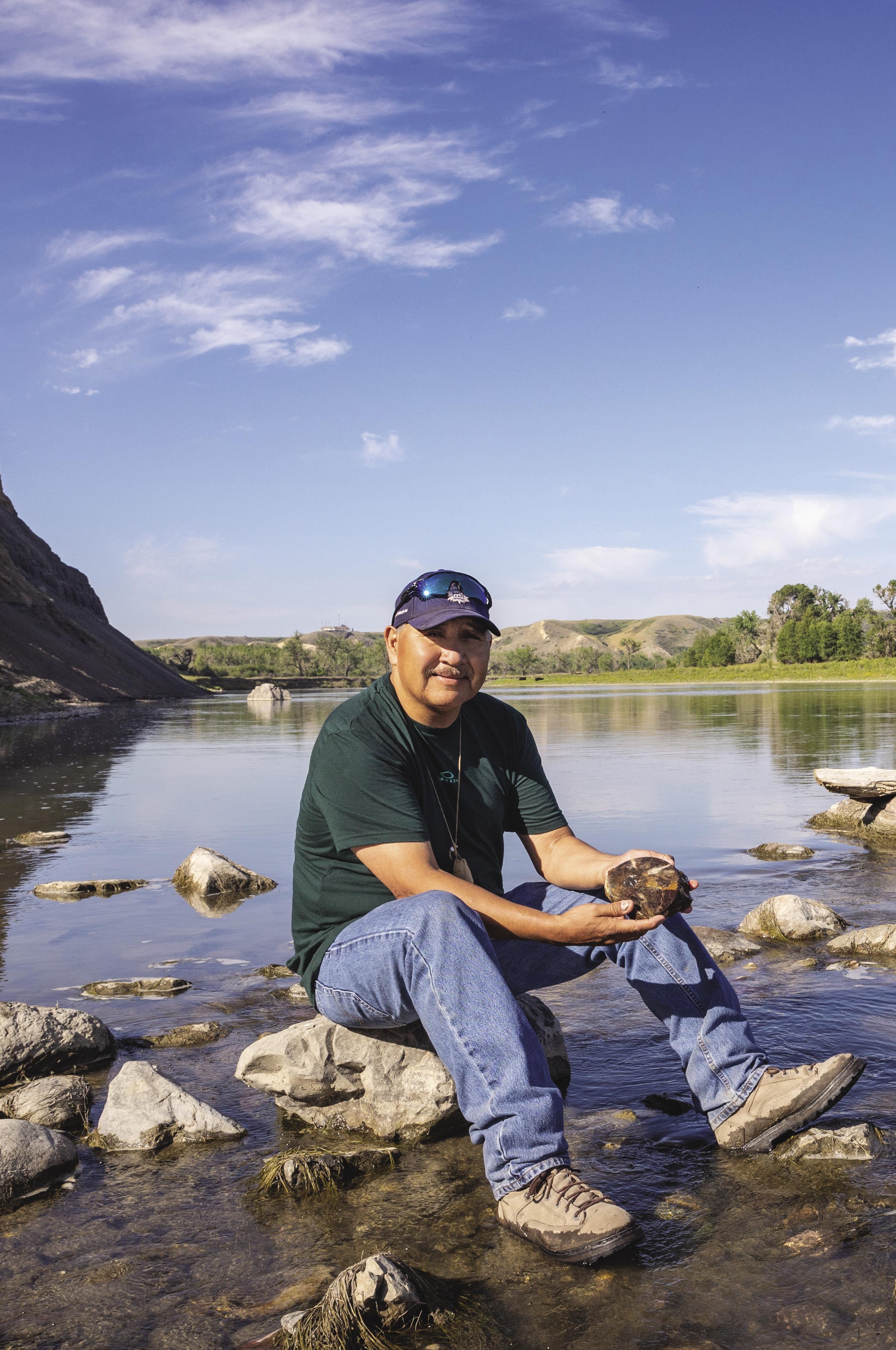
46 | FALL 2023
“Troy came to me to determine what he needed to do to complete the requirements,” says former chair Halma. “He told me about his business, and his hopes for leadership within the Piikani Nation. I could see the value of him having a completed diploma, but the most significant factor was that he wanted it as much for his mother as he did for himself. That spoke deeply to me, and I went to bat for him to ensure he could get it done in time.”
Knowlton followed through, and with Halma’s guidance and support, successfully completed the remaining course. He walked across the convocation stage to receive his Business Administration – Management diploma in 2016.
“Coming to the college was a catalyst for where I am today,” says Knowlton. “From the business courses to public speaking, and everything else associated with my time there, it all prepared me for my work as an entrepreneur and to be an effective leader in my community – first on council and now as chief.”
Knowlton was first elected to Piikani Nation Council in 2000 and served a two-year term. He was elected again in 2015 and served two consecutive four-year terms until January 2023 when he was elected chief.
He admits he wasn’t sure he should run for chief but says overwhelming support from band members, including a well-respected elder who noted Knowlton’s connection to both the land and the people, encouraged him to try. A dream about a week before nominations – wherein his deceased aunt told him he would be chief, clutched his hands and prayed for him – sealed the deal. He ran and won by a landslide.
Calling the previous two terms of council “an old boys’ club,” Knowlton also advocated for more women to be elected. There are now four women serving alongside him, and he says he takes every opportunity to give them the space and time to lead as well.
While it’s too early to talk re-election, Knowlton says if a solid candidate steps up by 2027, he can retire from politics knowing the community is in good hands. At that point, he says he will happily step back into his private life operating Blackfoot Rocks and Gems.
“My story has come full circle,” he says. “Starting with my humble beginnings, the gifts I received and the challenges I overcame in addiction and poverty – I share it all with my own people, other First Nations, and anyone really, to try to encourage them to make good choices.”
Simply put, he says “get an education and get it while you’re young.”
THERE’S A NEW “BOSSMAN” IN THE FAMILY
TROY KNOWLTON SAYS HE’S BEEN “BOSSMAN” SINCE HE WAS TWO YEARS OLD.
“My grandfather would hold my hand and I’d lead him all around the house, pointing at things, and he’d do everything for me,” Knowlton says. “He also had this big Archie Bunker chair in front of the TV and no one but him sat in it. If anyone did, he would tell them to move.
“One day, my grandmother gave me a bath, wrapped me in a towel, stuck a bottle in my mouth and set me down on my grandfather’s chair where I fell asleep. My grandfather came in and saw me sleeping on his chair, but knew he couldn’t disturb me, so he grumbled a few things and sat down somewhere else. Everyone said, ‘look at the way the baby bosses the old man around – he’s a real boss man!’ My dad’s nickname was ‘the boss’ so they said, ‘I think we have a new bossy-man in the house.’ My grandmother would tell that story to everyone, and it stuck with me.”
Knowlton says until he was elected Chief of the Piikani Nation, many people knew him only as “Bossman.”
47
THE STORY OF AN INISKIM:
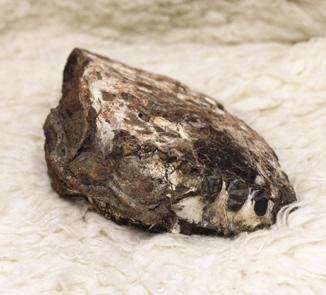
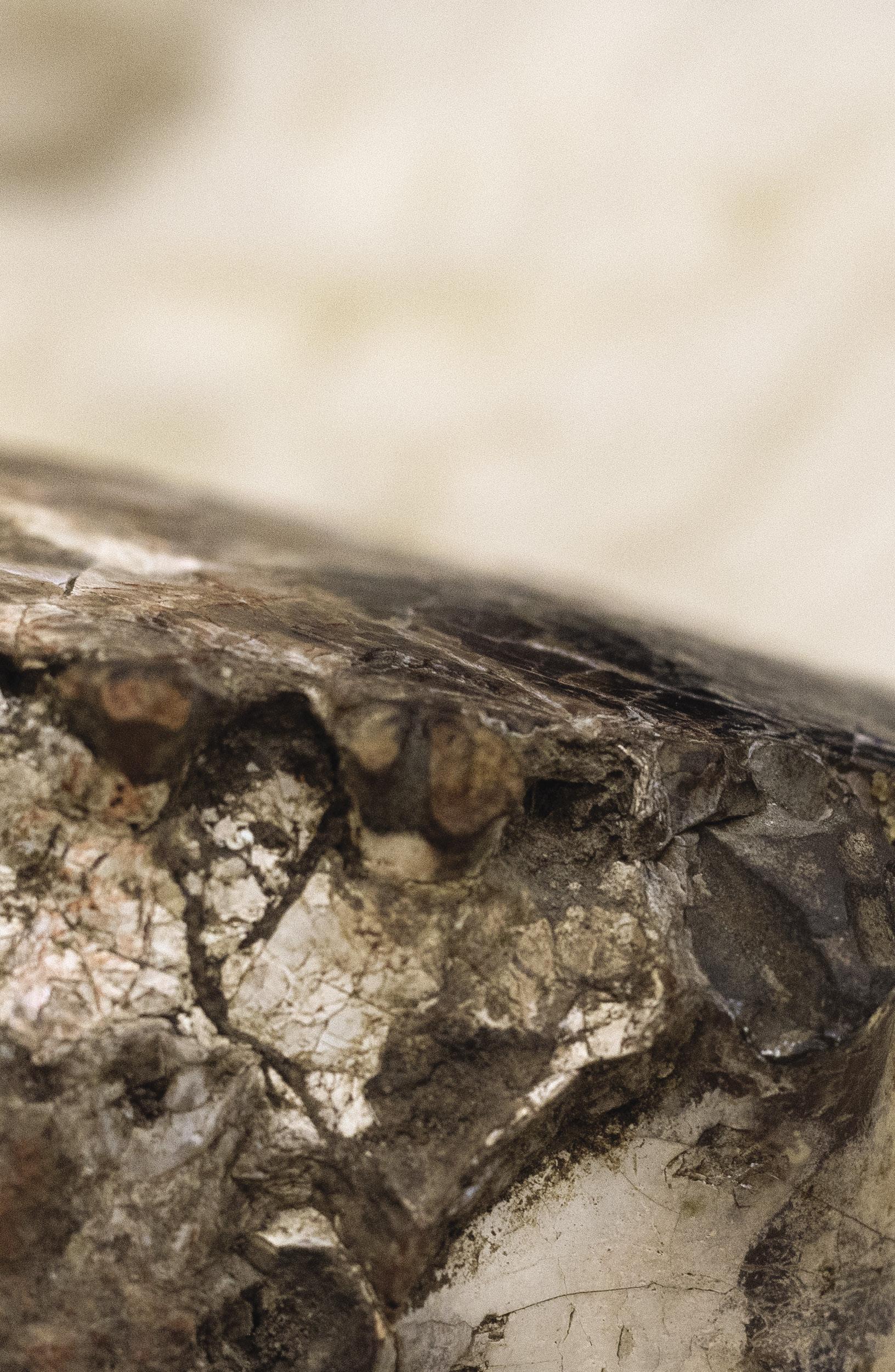
‘LOOK AT ME, I HAVE BEEN HERE ALL THIS TIME’ 48 | FALL 2023
It is a hot August summer evening and I’m sitting at the kitchen table. The sound of the flies buzzing around the black garbage bag and the smell of the rotting potato peels inside easily motivate me to get up off the chair, slip on my Birkenstocks and walk down to the garbage bin. I hold my breath as long as I can while making the trek down to the bin, as the smell is pungent and powerful. At last, I swing the bag a few times back and forth to gain momentum to aloft it into the tall blue garbage bin. I brush my hands together to dust off any germs and dirt.
I make my way back to the house. I’ve walked this path what feels like a million times over the 30-plus years I’ve lived here. As a kid, my delegated chores after dinner were to take the garbage out to the bin. I can confidently say it was the same routine every day: 38 steps, the caragana bushes on the right, red crunchy shale below my feet, three big potholes, the three rock gardens on the left, and past the smell of the chicken coop. In fact, I could walk this route to the garbage bin with my eyes closed and find my way safely there and back with confidence.
However, this particular hot blistering summer evening, something is very different. As I make my way back to the house and approach the last rock garden on the right, before making my way
to the last step to the back entry, I am blinded by a beam of light. A rock the size and shape of an inflated football is sparkling so intensely that I can’t ignore its rainbow patterned iridescent shell, nor the fact that it speaks to me loudly and clearly in these words: “Look at me,” it says. “I have been here all this time waiting for you to see me at last and identify what this means for you moving forward.”
I know right away this was an iniskim (Buffalo Stone) and what an incredible and honourable moment this is for me. It was only a few weeks prior, during my Master of Education program Niitsitapiisinni: Real Peoples Way of Life, where I learned the significance and power behind possessing one of these stones. These buffalo stones are the remnants of ammonite or baculite. They come in the shape of a buffalo and are said to possess unique properties. Blackfoot legend tells us that the first Buffalo Stone saved an entire clan of starving people. This stone is strong medicine. It gives its owner great power with buffalo. The person who succeeds in obtaining one is regarded as very fortunate. The fact that this Buffalo Stone had been living in that rock garden all these years and never revealed itself to me is a true lesson in patience. It tells us that timing is everything, and that everything happens for a reason.
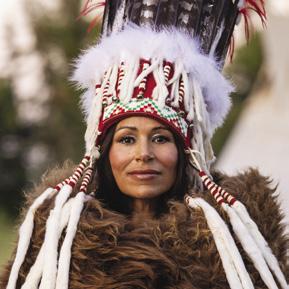
49
Story by Marni Hope (Miisomii’kitsikaakii/Long Time Offering)
In 2001, shortly after Chef Mark Dieser arrived to start teaching at Lethbridge College, Chinook Country Bison asked the team in the Culinary program to create some recipes for their cookbook, titled Bison: Naturally Nutritious. Led by Chefs Allen Clampitt and Rob Sonnenberg, the team sent 10 recipes – ranging from bison vindaloo curry on rice pilaf to bison paté maison with Saskatoon sauce to bison cabbage rolls with tangy tomato sauce, and more.
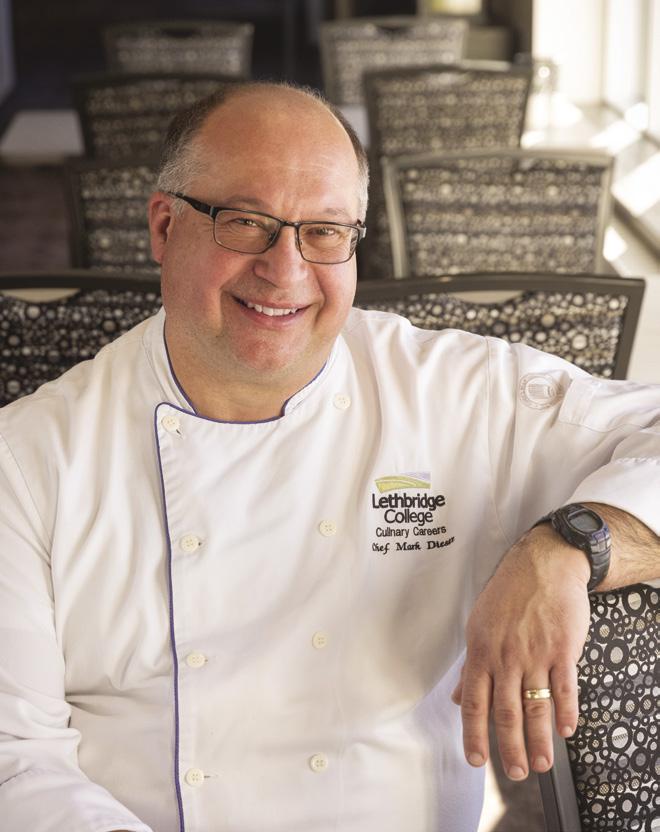
Dieser says there are many good reasons to cook with bison – it’s leaner than many meats, easy to work with and readily available in a lot of different cuts. He suggests cooking all bison cuts to medium rare to best enjoy them – aside from ground bison, which should be cooked to well-done. Students in Lethbridge College’s Cook apprentice program cook with bison or game as part of the third-year curriculum, and bison has been featured in Local Producers’ Dinners that were held before the pandemic.
INGREDIENTS
FOR THE BISON BURGERS
2 tsp. vegetable oil
1 c. .................................................................. small-diced onion
1 c. small-diced celery
2 cloves crushed garlic
1 kilo. ground bison
1 tbsp. parsley
2 beaten eggs
1 tbsp. seasoning salt or steak spice
1 c. ......................................................................... breadcrumbs
FOR THE BANNOCK BUNS
3 c. flour
1 tbsp. baking powder
½ tsp. salt
½ tsp.
ground black pepper

1 ½ c. ...................................................................................... water
As needed vegetable oil
METHOD
1. Heat oil and sauté vegetables and garlic until transparent. Cool.
2. Combine cooled vegetables, ground bison, parsley, egg, seasoning and breadcrumbs.
3. Shape evenly into eight patties. Sauté, griddle or barbecue until juices run clear.
4. Combine dry ingredients in mixing bowl. Gradually mix in water to form a soft sticky dough.
5. Turn dough out onto a lightly floured surface. Divide into eight pieces. Press each ball into a small pizza-like circle no more than 1 cm thick, being sure to flour the surface frequently. Deep fry or pan fry in a moderate amount of oil on low heat for about five minutes on each side. Do not burn before centre is cooked.
6. Allow buns to cool on paper towels. This helps absorb excess fat.
7. Slice buns and serve bison patties with toppings as desired. Enjoy!
To check out all 10 recipes that were included in the bison cookbook, go to widerhorizons.ca.
To enjoy the delicious culinary creations of Chef Dieser’s students this fall, book a table at the Garden Court Restaurant by calling 403-320-3230. Bon appétit!
From our kitchens
Story by Lisa Kozleski
50 | FALL 2023
BISON BURGER in a Bannock Bun

{ Chef MARK DIESER }
51
Where are they now?
Makers, Doers and Thinkers
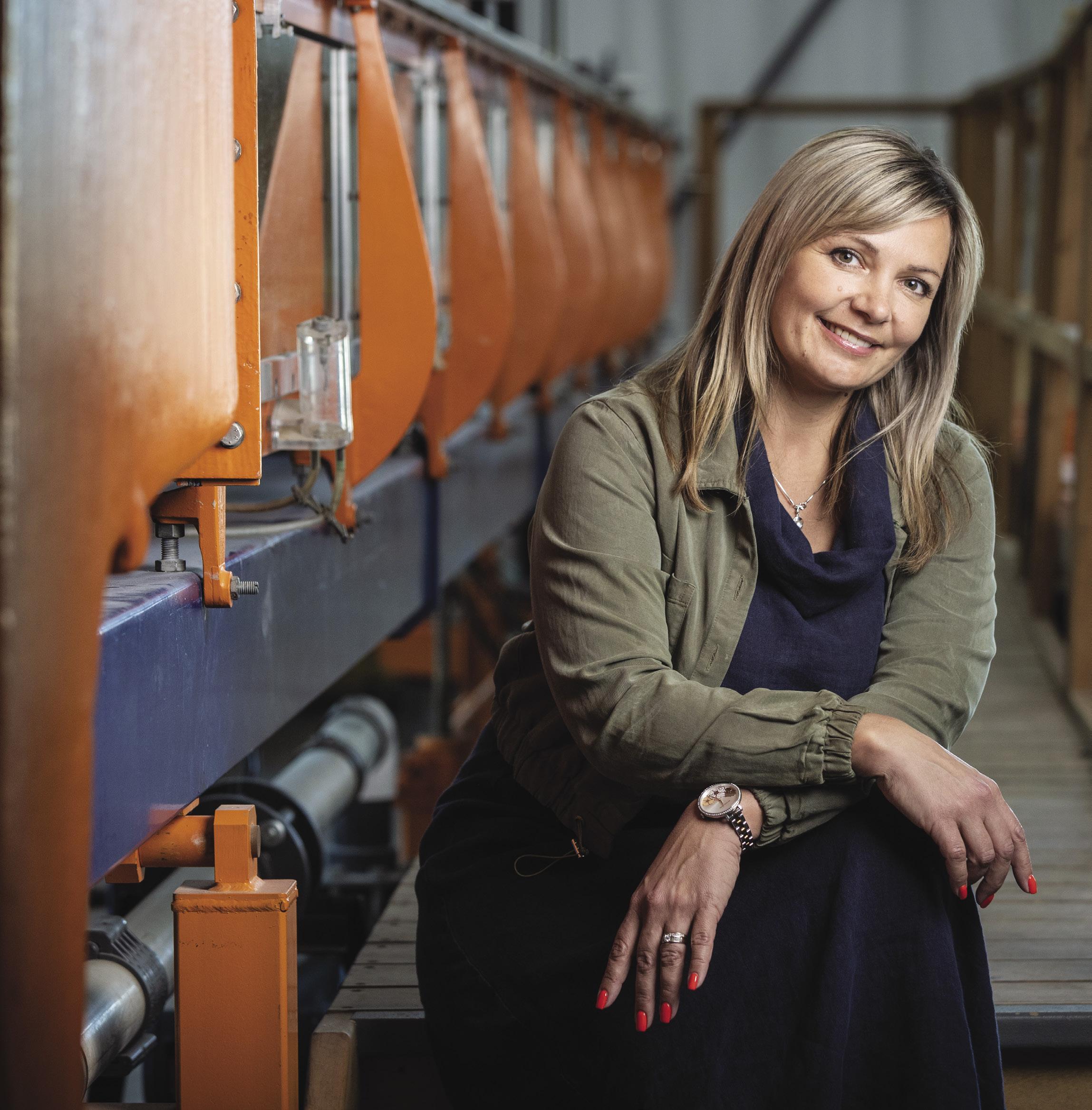
Where are they now?
Celebrating the Lethbridge College alumni who are building community and making their mark in memorable ways.
Mila Wagner Civil Engineering Technology 2020 52 | FALL 2023
FEATURING:
SHARING THE SUCCESSES OF OUR ALUMNI IN THEIR CAREERS AND THROUGHOUT THEIR LIVES.
In 2016, Mila Wagner (Civil Engineering Technology 2020) left everything she had in Kyiv, Ukraine – her apartment, her job and her family – to move across the world to Canada in search of a better life for her and her then three-year-old son.
S even years later, Mila was able to celebrate her first Canada Day as a citizen, only a few months after winning a prestigious award from the Association of Science and Engineering Technology Professionals of Alberta (ASET). Her journey to success, however, has been her biggest engineering project yet.
When Russia first invaded Crimea in 2014, Mila quickly realized her home country was not a safe place to raise her son. It took two years of planning before the two of them landed in Calgary. She had friends who had already moved to Alberta and recommended the province for her new life. It wasn’t easy, though. Not only did Mila need to learn English, but her multiple engineering technology-related degrees from Ukraine were not fully recognized in Canada.
“It was a challenge for me to start all over again with just my little boy holding my hand,” recalls Mila, who says her son Nikita gives her the motivation to keep moving forward every day. “I had to take menial jobs, mostly cleaning, to pay for English schooling, rent and food. I wanted to be a good example for my son and show him that you don’t need to be afraid to start all over again.”
When Mila met the man who would become her husband, she made the decision to return to school and was accepted to the Civil Engineering Technology program at Lethbridge College. Her drive and dedication quickly paid off. Mila and two of her classmates wrapped up their final year with a capstone project that was a finalist for ASET’s Capstone Project of the Year Award.
After graduation Mila was hired at MPE Engineering as a civil engineering technologist-in-training, and she’s worked for three years and is on her way to getting her professional designation from ASET as a certified engineering technologist. Mila has also spent a significant amount of
time volunteering with ASET as an interview subject for their province-wide media campaign for two initiatives: a fee waiver for engineering technologists with refugee status and its competency-based assessment program. The latter was launched in 2016 to give foreign-trained and other engineering technology professionals a faster route to establishing careers in Alberta. Mila’s work with ASET led to her receiving one of the association’s highest honours as the winner of its inaugural CEO Award – the first handed out in ASET’s 60-year history. This award is bestowed upon an ASET member at the sole discretion of the CEO and celebrates Mila’s contributions to increasing public awareness of their initiatives.
“For me, winning this award is remarkable,” says Mila. “I didn’t expect it, but it was my pleasure to serve my profession and community and help provide information that will give a leg up to people who just arrived in Canada. This is an inspiration to keep going on the road I’ve been heading down.”
“For me, winning this award is remarkable. I didn’t expect it, but it was my pleasure to serve my profession and community and help provide information that will give a leg up to people who just arrived in Canada.”
Aiding new Canadian citizens is something Mila truly takes to heart. Just as her friends did for her, Mila has now helped both her niece and her best friend come to Canada, and she is working on bringing her parents safely over. She calls them at least once and sometimes twice a day, and she says winning the award from ASET gave her the chance to share good news with them while her successes bring her closer to moving them to Canada.
“I have a wonderful job at one of the top 10 engineering companies in Canada, and I’ve been able to grow as a professional,” Mila says. “But my biggest success is being together with my family.”
Makers, Doers and Thinkers Featuring
Story by Melanie Fast | Photo by Rob Olson
53
ALUMNI UPDATES
We love hearing from Lethbridge College alumni! You can find additional updates online at widerhorizons.ca. To submit your news to share with your classmates and the college community, drop us a note at WHMagazine@lethbridgecollege.ca.
2022
Aaron Lowe Massage Therapy
Aaron is the owner of Aaron Lowe Massage, which is located inside Body and Soul Chiropractic in Lethbridge.
2021
Emily Freiberg
Agriculture Sciences –Plant and Soil Sciences
Emily was among the Farm Family Outreach team members who were featured in a May article in Greenhouse Canada. She is currently farming with her family near Bow Island and says before being part of the outreach team, she worked at a crop inputs store and for a seed canola company. “I feel very excited about the opportunity to help farm families through the Farm Family Outreach team and subsequently Family and Community Support Services,” Emily says. “Having grown up on a farm and currently being involved in my family’s farm, I know that farming can be an extremely beautiful but also challenging lifestyle. My background in farming is also what created my
passion for this position, and ultimately led me to apply for the job. I know that this program holds great potential to enrich farm families’ lives, and I am very thankful to be a part of this and work towards creating a better future for my family as well.”
2020
Nolan Hoffart
Bachelor of Ecosystem Management
2020; Renewable Resource Management 2017
Nolan was featured in an April story in the Calgary Journal that shared how the Bar None Ranch south of Calgary, where Nolan works as the lead aquaculture technician, is raising barramundi – also known as Asian sea bass. Barramundi is a white-fleshed fish native to the IndoWest pacific region, but the Bar None Ranch raises them for provincial markets here in Canada. While at the college, Nolan worked as a student aquaculture technician as part of the college’s Aquaculture Centre for Excellence.
Sarah Jorgensen
Business Administration – Marketing 2020; Information Specialist/Office Assistant 2000
Sarah is a co-owner of Lethbridge Tactical Supply, which has been supporting southern Alberta first responders and the well-prepared for more than 11 years.
Victoria Nelson Justice Studies 2020; Criminal Justice – Policing 2018 Victoria has been accepted into a master’s degree program in Human Rights at the University of Manitoba.
Alysha Ramus
Bachelor of Nursing
Alysha was a nursing student in the Bachelor of Nursing program offered by Lethbridge College and the University of Lethbridge when, at age 25, she was diagnosed with cancer. She fulfilled her academic requirements, including submission of a final assignment, and received her degree in March 2020 in a special convocation ceremony in a hospital. Alysha lost her battle with cancer on July 15, 2020. Her family granted Canadian Nurse permission to publish a three-part essay on her final words to the profession. Her essay can be viewed at learn.lc/ramus.
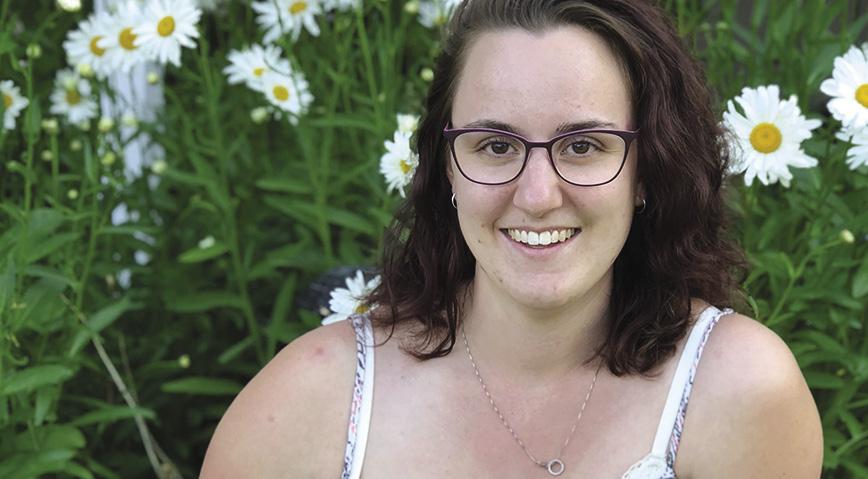
2019
Bernard White Man Left III (Eeetoomoo/The One Who Leads) Open Studies
Bernard was featured as a “shining graduate” at the University of Lethbridge’s graduation, and was a speaker at his ceremony as well. He said it was humbling and an honour to be chosen to address his peers at a pivotal moment of their lives. “I wish for the next set of graduates that come after me… I hope that all the opportunities that I have achieved, that they will achieve it but in their own capacity, their own state of mind.”
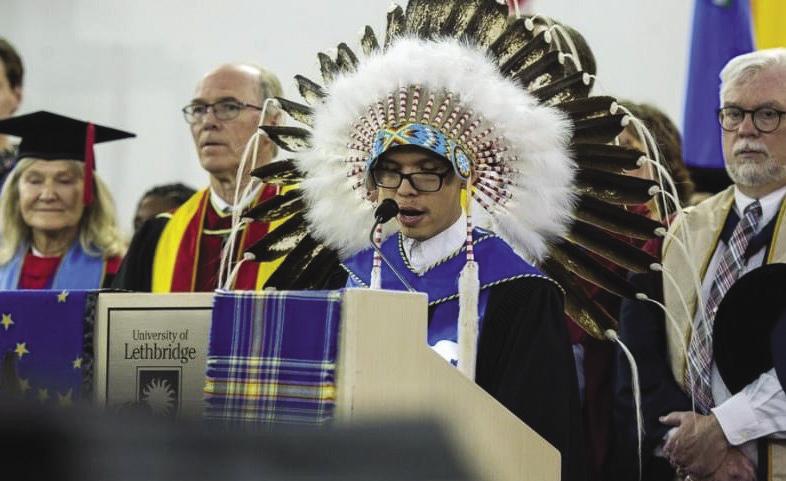 Photo courtesy the Ramus family
Photo courtesy the Ramus family
Where are they now? LEARN
lethbridge. alumni-perks .com 54 | FALL 2023
Photo courtesy the University of Lethbridge.
MORE ABOUT THIS GRAD’S BUSINESS ON THE LC MARKETPLACE, WHICH IS PART OF THE LC ALUMNI PERKS APP. GET THE DETAILS AT :
2018
Josh Mackenzie
Digital Communications and Media
Josh runs Vinyl Spin YVR (formerly “YQL” before relocating to Vancouver in 2021), a pop-up shop and online blog for vinyl records and collectors. The business has grown to become a reputable source for learning about, sharing and buying vinyl records.
2017
Keiran Bodnar
General Arts and Science –Psychology and Sociology
Keiran was featured as a “shining student” at the University of Lethbridge, where he has taken every opportunity to engage in research. After graduation, he hopes to continue studying in a master’s program in clinical psychology.
Jonathan Mah Business Administration –Accounting
Jonathan is the founder of SoNormal Print, a Lethbridge-based company that was founded in 2020 with a vision to provide the local community with high-quality custom printed shirts. The company opened its flagship store in 2023, bringing its passion for direct-to-garment printing to life. The company uses state-of-the-art technology and premium materials to create exceptional designs with meticulous attention to detail.
2014
Noelle Hughes
Massage Therapy
Noelle is the owner of Driftwood Balance Massage and Wellness, which is made up of a small, inclusive and caring team of massage therapists and other health practitioners who specialize in deep tissue barefoot massage (Ashiatsu), therapeutic, medical and relaxation massages.
Leanne
Veldboom
(Practical Nurse 2023)
What began as a quick trip to campus to pay her daughter’s tuition ended with Leanne Veldboom fulfilling her lifelong dream of becoming a nurse. While she says she was happy as a stay-at-home mom, Leanne admits she had always contemplated going back to school. So, when “the perfect academic advisor” at Lethbridge College encouraged her to take the leap and register, she did. “I went to my first class that afternoon,” she laughs.

Leanne started with General Studies and upgrading classes in the fall of 2019 and began the Practical Nurse diploma program the following year. She took a year off during the COVID-19 pandemic and returned for her final two semesters in the fall of 2022. This past spring, a panel of Leanne’s instructors named her the first recipient of the Katharina Martha Herbst Practical Nurse Award. It’s given to a graduate who has demonstrated exemplary care and kindness to their patients and who has an interest in lifelong learning. (Read more about the award, and the family of nurses behind it, on page 59.)
“There were a lot of well-deserving students, so that was a huge honour,” she says. “And it affirmed my decision to go back to school and successfully finish the program.” Leanne says she’s “slightly terrified” to be done with school and applying for jobs, but she is eager to get started. “It’s a great privilege to be invited into people’s lives – often when they’re sick and feeling their worst – so I’m looking forward to it.”
by Linda Sprinkle
Photo
55
“There were a lot of well-deserving students, so that was a huge honour and it affirmed my decision to go back to school and successfully finish the program.”
Where are they now?
Chase Chambers (Digital Communications and Media 2023)
Chase Chambers learned from some of the best in the business this spring thanks to a story he submitted in competition for this year’s Troy Reeb Internship offered by Lethbridge College. Chase penned an in-depth article on the gender inequality of Canadian Collegiate Athletic Association crosscountry races – men run eight kilometres while women only run six.
This is the second time Chase has made it to the final phase of the Troy Reeb Internship selection process. As a first-year DCM student, he was selected for the interview round based on a story he had written about farming technology. The annual internship, sponsored by Reeb, has been available to Lethbridge College DCM students for the past 18 years. A 1988 graduate of the college’s Broadcast Journalism program, Reeb is now Executive Vice President, Broadcast Networks for Corus Entertainment. He was also named a Distinguished Alumni in 2003 and received an honorary degree in 2019.
“In addition to a unique and well-researched story idea, Chase has demonstrated a strong work ethic and willingness to learn that made him an ideal candidate for this year’s internship,” says Reeb. As part of his internship experience, Chase took an all-expenses-paid trip to Toronto and Ottawa where he spent 10 days getting hands-on experience with Global’s online news platforms, television and radio stations. Chase also worked on Parliament Hill with the Ottawa bureau of Global National.

Chase says he was excited to put the skills he learned with Global to work during his summer internship at RealAgriculture in Lethbridge and in the fall when he begins the Film and Video Production program at SAIT. “I really enjoy visual storytelling,” he says. “The DCM program here at the college gave me a strong foundation for the media industry and a lot of experience in writing and in journalism. Now I’m hoping to really hone my film and video capabilities to round-out that skillset.”
2013
Blake Hranac
Civil Engineering Technology
Blake was named the Municipal Energy Manager of the Year by the Municipal Climate Change Action Centre. From 2021 to 2023, he had worked as the municipal energy manager for the Town of Taber, where he helped the town develop an energy management plan and supported significant projects. For example, Blake helped bring 13 electric vehicle charging stations to Taber and supported the Aquafun Centre’s combined heat and power half milliondollar installation. He also made LED and smart thermostat upgrades in several facilities, enrolled Taber in the Demand Response Program, and helped procure an electric ice resurfacer. He recently moved into a new, full-time position as facilities and energy manager for the Town of Taber.
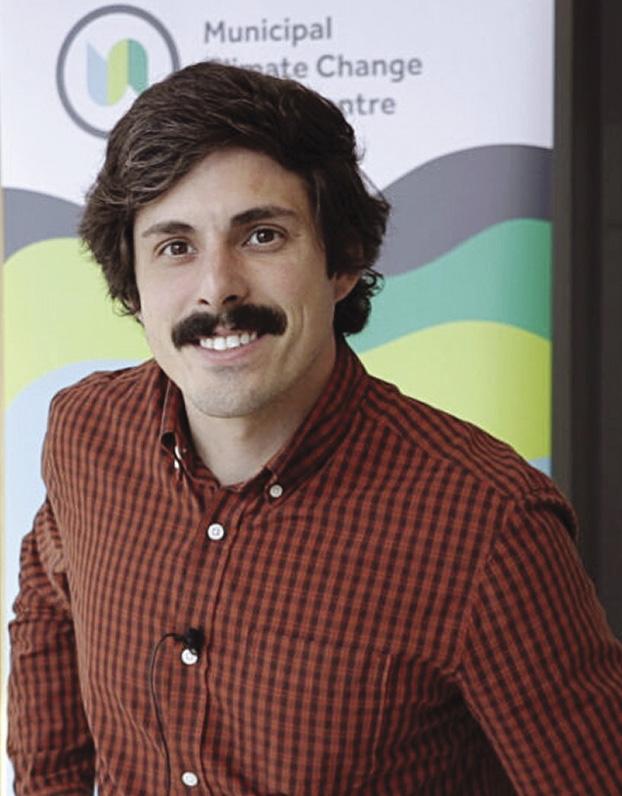
2012
Neil Sharp Adze Business Administration –Management
Neil, who was one of eight people elected to the Piikani Nation Council in January 2023, brought greetings from the First Nation to the graduates of F. P. Walshe School in Fort Macleod in May.
56 | FALL 2023
Photo by Tanner Fletcher
2009
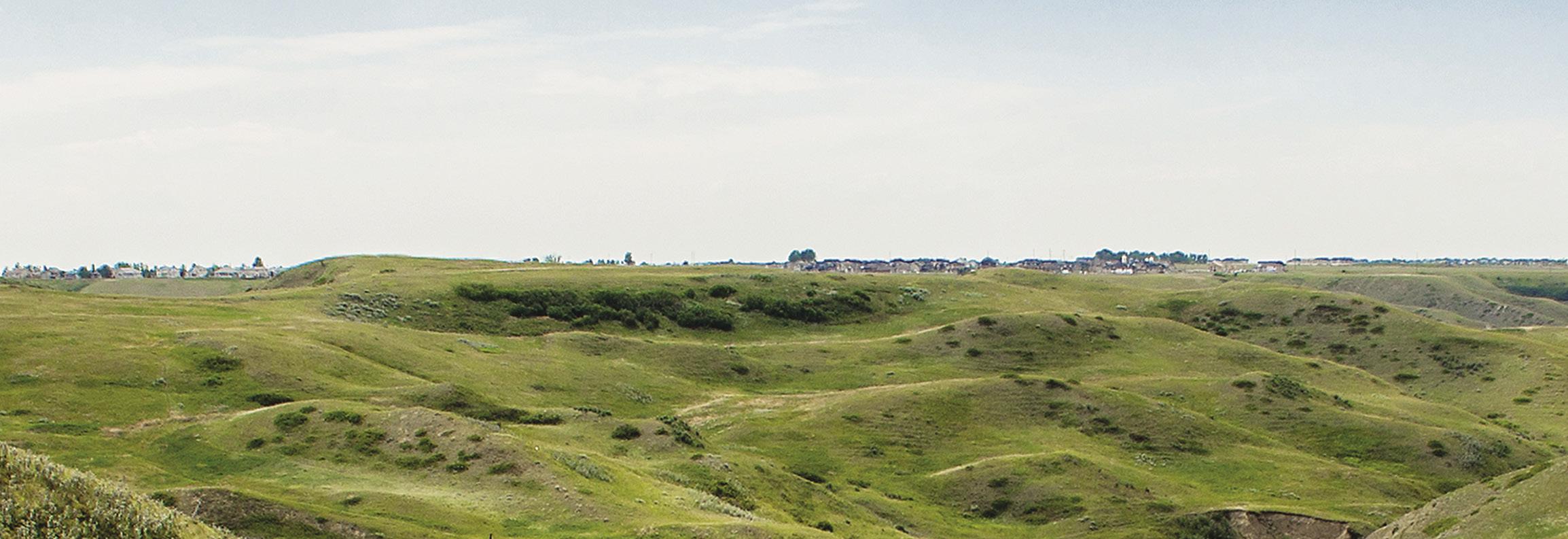
Jordan Schellenberg
Criminal Justice – Policing

Jordan is the CEO and founding partner of Youth One, a youth and family centre offering mentorship-based programs, meals and support services for youth. Programs are designed to give students a community of belonging, support and guidance during their most formative years. Youth One was launched in 2014 to provide more affordable, quality driven, mentorship-based programs supporting youth after school. Since then, Youth One has supported thousands of individual young people through their middle school and high school years through afterschool drop-in programs, support groups, leadership training, food services, life skills development and more.
2007
Chris Broughton Business Administration –Management










Chris is the principal consultant and human resources business partner at UpSourced HR, which is a fractional human resources company specializing in delivering comprehensive, scalable, and personalized HR solutions for organizations of all sizes. UpSourced HR provides a one-stop-shop for organizations seeking to streamline their human capital management processes.
2003
Dan Van Harberden
Automotive Service Technician 2003 When Dan Van Harberden was about to graduate from high school, a counsellor suggested university. That didn’t feel like the right choice, though, because “I didn’t know what I would be doing there, and I didn’t have a goal,” he recalls. “But the trades were something I was interested in – and I’ve never regretted it for a moment. In my opinion, it’s one of the best ways to learn.”
After completing the program, Dan went to work in the industry for more than a decade, until the opportunity in 2016 to return as a teacher to the high school he had attended – Calvin
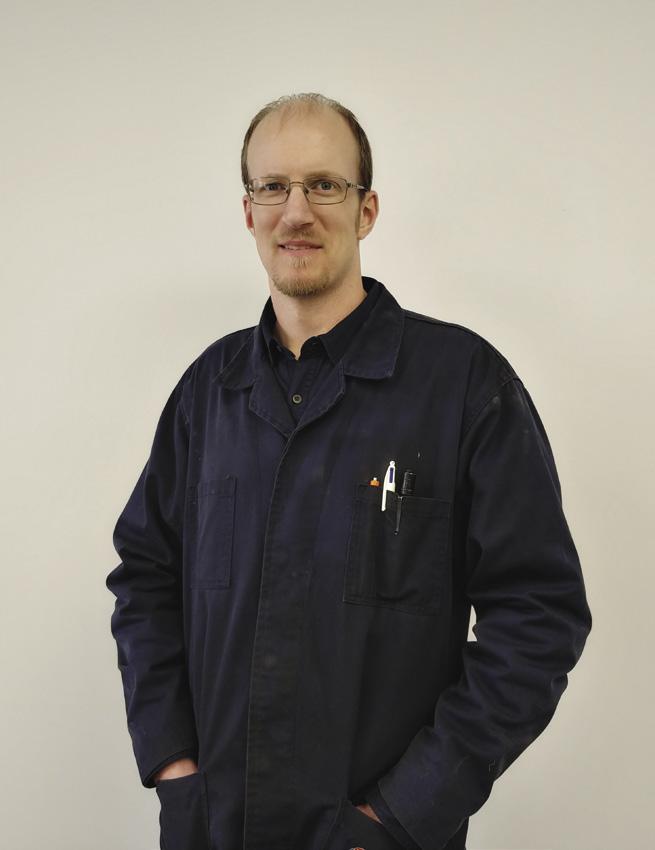
Christian School near Monarch – was too good to pass up. So, he enrolled in a “bridge to teaching” program at the University of Alberta, where he received credit for his previous credential, completing it in 2021 and thriving in the classroom along the way. He now teaches shop, mechanics, robotics and science in the secondary school. “I really enjoy it,” he says. “It’s always great to solve problems with the students. I still get to do the hands-on work in the shop, so it’s not as if I stepped completely away from my toolbox.”
And he remains grateful he started off in the trades – and now encourages his own students to consider those options for rewarding careers. “It gave me a huge step in the right direction at a young age, and it gave me the financial stability to even consider switching into teaching,” he says. “For students who are like I was – and are unsure what they would do in university… I tell them a trade is the way to go.”
“It’s always great to solve problems with the students. I still get to do the hands-on work in the shop, so it’s not as if I stepped completely away from my toolbox.”
Join in the fun at Lethbridge College’s free family festival.
• Live music, food trucks and Hudsons Canada’s Pub beer gardens
• Prairie Made Market
57
• Petting zoo, games, family entertainment and more
Cody Erman (Heavy Equipment Technician 2018, Parts Technician 2013)
2002
Kip Kangogo
General Studies student
ALethbridge College-trained apprentice has been named AGCO Corporation’s 2022 North American Technician of the Year after an intense test of skills over three days against four other top technicians. Cody Erman works at Hanlon Ag Centre in Lethbridge. In early March, he and technicians nominated by their AGCO dealerships from Manitoba, California, Idaho and South Dakota travelled to Hesston, Kansas, where they were tasked with diagnosing and repairing six different machines. They had just 2½ hours per machine. Their work was judged by a three-person panel representing the customer, the service manager and a technical support person. Their scores were based on the way they interacted with each judge, the questions they asked and their diagnosis and repair skills.
Cody says the time limit was stressful, and he was worried after not completing the first six tasks. He later found out none of the competitors completed the first project. With that experience, he settled in for the rest of the competition, winning the title and a $5,000 grand prize. The prize is just the latest highlight in a trades career Cody says he’s never regretted pursuing.
“I enjoy hands-on work and dealing with people in the field,” he says. “It’s rewarding to be able to fix something. You’re always problem solving, and there’s so much technology involved now. A problem could be mechanical or electrical. You have to be able to talk to the customer, find out what was happening when the problem started, and then systematically figure out the cause.” Success in the trades is more academic than people realize. “I am a lifelong learner. I take training every year to keep up on all the new technology that’s being introduced. Every year, there’s more to learn.”
SHARE YOUR THOUGHTS!
We want to hear from you – about what you love, what stories you’d like to see in the future, and more.
Complete this survey before Oct. 15, 2023, and your name will be entered into a draw for a $100 gift card to either Tim Hortons or Starbucks. www.surveymonkey.com/r/WGHJPTH

WE CAN’T WAIT TO HEAR FROM YOU!
Kip finished in fourth place in this year’s Vancouver Marathon, crossing the finish line in 2:25:29. When Kip was running for the Kodiaks, he won every race he ran his first year at the college – including those at the provincial and national levels.
2000
Wayne Gryde
Engineering Design and Drafting Technology
Wayne is the owner of eSkape
Drafting and Creative Services, which provides mechanical drafting services and specializes in 3D modelling using SolidWorks software to create prototypes or final manufacturing drawings.
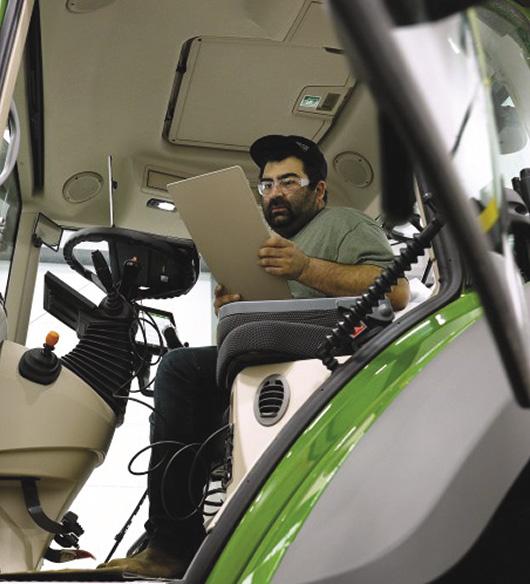
1996
Lowa Beebe
Information Specialist
Lowa received this year’s Chief David Crowchild Memorial Award from the City of Calgary’s Aboriginal Urban Affairs Committee. The award is presented each year to honour demonstrated leadership in building relationships between Aboriginal and non-Aboriginal communities in Calgary; displaying a commitment to building bridges between the Aboriginal and non-Aboriginal communities; supporting and encouraging effective engagement and activities between Aboriginal and non-Aboriginal communities; and creating and supporting positive changes in their community. Lowa currently works as a manager of Indigenous Services at MNP LLP and is the recent co-founder of The Path Forward. This innovative firm is a 100 per cent Indigenous women-owned entity offering corporate education on reconciliation and Indigenous intercultural competency through a variety of courses, events, and expert consultations.
Where are they now?
58 | FALL 2023
The Herbst Family
What do you get a woman who’s about to turn 80 and has everything she needs?
That was the challenge facing sisters Carla Herbst (Nursing 1988) and Michelle Herbst Sutor (Nursing 1993) ahead of their mother’s milestone birthday this past July.
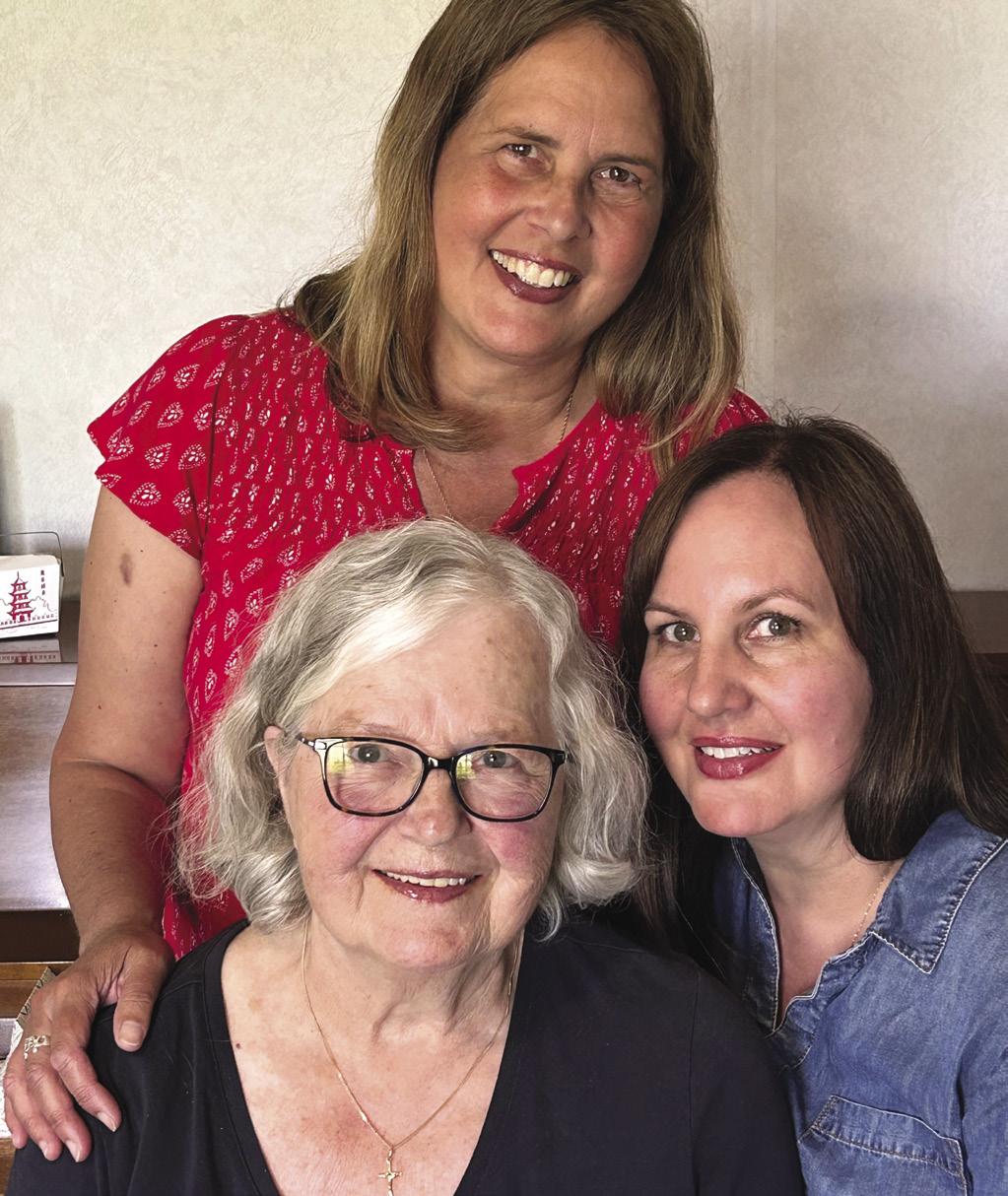
Wanting to celebrate not only an inspirational wife and mother, but her lengthy career as a Licensed Practical Nurse and her passion for lifelong learning, Carla, Michelle and their father, Stan, decided to create a Lethbridge College student award in the name of Katharina “Kathy” Herbst.
“In a time when women weren’t as recognized in the workforce, and after all her family had been through, she made sure she got an education,” says Carla. “When you have a desire to learn and to support yourself, you should be encouraged, and we want to do that for someone else.”
Kathy was born during the Second World War in an Austrian castle-turned-refugee camp and lived her first nine years at various German settlements around Europe. In 1953 she, along with her parents and seven siblings, immigrated to southern Alberta to work in the sugar beet fields.
As the youngest daughter, Kathy was never expected to go to college or have a career. Instead, she was encouraged to get married, have children and help care for her own parents as they aged. These traditional expectations didn’t stifle her desire to learn though, and she pursued a post-secondary education at SAIT’s School for Nursing Aids. She graduated in 1961.
Over the years, Kathy says she jumped at nearly every professional development opportunity that arose (and always with Stan’s support and encouragement), including a CPR Instructor course at Lethbridge College in 1989.
Knowing the value in education and the opportunities it creates, Kathy and Stan encouraged their daughters to go to college and pursue careers they were passionate about. Carla jokes that “nursing must be in our DNA,” because they both followed in their mother’s footsteps.
After graduating from Lethbridge College in 1988, Carla worked as a Registered Nurse on an antepartum/gynecology unit and now works in day surgery at Lethbridge’s Chinook Regional Hospital.
Michelle graduated in 1993 and worked as a RN in rural nursing, minor surgery, and as a nursing manager. She earned a Bachelor of Science in Nursing from the
University of Saskatchewan in 2011, and works in renal dialysis at Victoria Hospital in Prince Albert, Sask.
“The student award in my mother’s name means so much to our family and its legacy of caring for others,” says Michelle. “My dad says, ‘The price of living is giving’ and that is true in many ways. This is one thing our family can do to honour our mom and a career she loved.”
The Katharina Martha Herbst Practical Nurse Award of $1,000 will be given to one graduate who has demonstrated exemplary care and kindness to their patients and who has an interest in lifelong learning. The first award, given out in the spring, also included a special gift – a new watch.
“As a nursing student, I had to have a watch with a secondhand,” says Kathy, “but I couldn’t afford one, so I borrowed my brother’s through school. So, when I finally got my first paycheque, I went to a jewelry store and bought my own.”
The Herbst family says gifting the watch is a personal gesture they hope the recipient finds meaningful – and useful – in their nursing career.
Are you a multi-generational Lethbridge College family? If at least three members across one or more generations attended Lethbridge College, let us know by emailing WHMagazine@lethbridgecollege.ca. We’d love to profile you.
FAMILIES IN FOCUS
Story by Tina Karst | Photo submitted
59
Above: Carla Herbst (top), Kathy Herbst (bottom left), Michelle Herbst Sutor (bottom right).
THE LAST WORD
Illustrated by Eric Dyck




The welding program at Lethbridge College started in 1963 with one instructor and a small shop of 12 booths. Over the years, it has grown into something remarkable: a thoughtfully designed, welcoming teaching space with 60 student booths and three demonstration booths outfitted with the latest technology. Wider Horizons asked a student, an instructor and a grad to share some memories of the space. Here’s what they had to say:
My time at the college has been very enjoyable as well as informative. The welding shop is truly state-of-the-art, with every tool and welding machine there to assist in your practical learning. The staff go above and beyond to teach you not only the practical aspects but the theory, math, science and safety within this trade
Austin Smith First-year Welding apprentice
Our program continues to positively affect the welding and fabrication industry in our community, and alumni enjoy the benefits of a great career because of what we do to help them achieve success. The passion we have for our trade truly lives on through the lives of those who graduate from our program. While this is in itself a great achievement, I feel it is an even greater achievement to have been blessed enough to have been present to help students grow personally. In one alumni’s words, “I became a better person because of enrolling in this program.”
Pat Bjorn
Apprenticeship Welding instructor since 2006 (Welding 2000)
Many years ago, I had a brother-in-law who was a welder, and I thought “I wish I could do that.” Fast forward to being in my 40s. My wife said: “Paul, you want to weld, it’s not too late, it never is.” I found a company who would take on an older man to be at the bottom as an apprentice. It was humbling and a challenge. I enrolled as an adult student at the college’s first-year welding program. I was finally working with METAL! The sparks, the rush of melting metal and creating were exhilarating. Three years flew by and it became my own. I started creating art with metal on the side and doing more custom requests. Fabrication is my passion.
Paul Henrie Owner of Crane and Henrie (Welding 2016)
The last word
60 | FALL 2023
NEXT ISSUE: The last word is yours...

Home away from home
Did you call Cullen, 30th Ave. or Kodiak House home while you were studying at Lethbridge College? Did your first-year roommate become your life-long friend? We want to hear your family-friendly stories about life in res. Just email your memories to WHMagazine@lethbridgecollege.ca and we’ll share your stories in our next issue.
We can’t wait to read your submissions!
SOCCER
w m
CROSS-COUNTRY RUNNING

Sept. 9 @ Concordia
Sept. 16 @ SAIT
Sept. 30 @ Lethbridge College
Oct. 14 @ Augustana
ACAC Championships
SAVE $5!
Show this ad at the Lethbridge College Bookstore between Sept. 1 and 30, 2023, and receive $5 off one Lethbridge College clothing item tagged at $30 or more.
Mar. 13
Feb. 22 – 24 Women’s ACAC Championship
Hosted by Lethbridge College
Feb. 22 – 24 Men’s ACAC Championship
Mar. 8 – 11 CCAA Nationals
kodiaks.ca
VOLLEYBALL w m Oct. 21 AMB 6 p.m. 8 p.m. Nov. 4 UAA 1 p.m. 3 p.m. Nov. 11 MHC 6 p.m. 8 p.m. Nov. 24 RDP 6 p.m. 8 p.m. Nov. 25 RDP 1 p.m. 3 p.m. Jan. 26 OC 6 p.m. 8 p.m. Jan. 27 OC 1 p.m. 3 p.m. Feb. 3 SAIT 6 p.m. 8 p.m. Feb. 9 NAIT 6 p.m. 8 p.m. Feb. 10 NWP 6 p.m. 8 p.m.
Sept. 9 RDP 2 p.m. 4 p.m. Sept. 10 OC Noon 2 p.m. Sept. 23 UAA Noon n/a Sept. 30 SAIT Noon 2 p.m. Oct. 14 AMB Noon 2 p.m.
Oct. 28 ACAC Championships Hosted by Lethbridge College at Nicholas Sheran Park 22 MHC 1 p.m. 3 p.m.
Oct.
Oct. 27 – 29
CCAA Nationals BASKETBALL w m Oct. 20 AMB 6 p.m. 8 p.m. Oct. 27 STMU 6 p.m. 8 p.m. Nov. 17 LAKE 6 p.m. 8 p.m. Nov. 18 KC 6 p.m. 8 p.m. Nov. 25 MHC 6 p.m. 8 p.m. Jan. 19 BC 6 p.m. 8 p.m. Jan. 20 BC 1 p.m. 3 p.m. Feb. 2 SAIT 6 p.m. 8 p.m. Feb. 16 CUE 6 p.m. 8 p.m. Feb. 17 TKU 6 p.m. 8 p.m. Feb. 29 – Mar. 2 ACAC Championships
– 16 CCAA Nationals
Nov. 8 – 11
For up-to-date game times and to see the futsal, indoor track and e-sports schedules, visit:
*This schedule is subject to change. go










































 LOWELL YELLOWHORN SPIITAWAKASI / TALL DEER
LOWELL YELLOWHORN SPIITAWAKASI / TALL DEER
 DR. TERRY KOWALCHUK
DR. TERRY KOWALCHUK















 KIAAYO MO-TA-GAAN / BEAR
KIAAYO MO-TA-GAAN / BEAR









 Photo courtesy the Ramus family
Photo courtesy the Ramus family


















